
ADMINISTRATIVE DIVISION
Game and Fish Director: Jeb Williams
Deputy Director: Scott Peterson
Chief, Administrative Services: Kim Kary
Federal Aid Manager: Corey Wentland
Administrative Staff Officer: Justin Mattson
Administrative Assistant: Lynn Timm
Building Maint. Supervisor: Brandon Diehl
Administrative Officer: Melissa Long, Alan Peterson
Accounting Manager: Angie Morrison
Accountants: Kelly Wike, Ashley Hillerson
Business Operations Manager: Brian Hosek
Technical Operations Lead: Alan Reile
Data Scientist: Shane Wegner
Licensing Manager: Randy Meissner
Assistants: Gail Mosset, Amanda Anstrom, Tracy Price, Tana Bentz, Tanya Mikkelsen
Administrative Assistant – Dickinson: Stephanie Richardson
Administrative Assistant – Devils Lake: Lisa Tofte
Administrative Assistant – Jamestown: Tonya Kukowski
Administrative Assistant – Riverdale: Mattea Bierman
Administrative Assistant – Williston: Nikki Wright
CONSERVATION AND COMMUNICATIONS DIVISION
Division Chief: Greg Link, Bismarck
Communications Supervisor: Greg Freeman, Bismarck
Editor: North Dakota OUTDOORS: Ron Wilson, Bismarck

R3 Coordinator: Cayla Bendel, Bismarck
Digital Media Editor: Lara Anderson, Bismarck
Video Project Supervisor: Mike Anderson, Bismarck
Photographer/Videographer: Ashley Peterson, Bismarck
Marketing Specialist: Jackie Ressler, Bismarck
Information Specialist: Dawn Jochim, Bismarck
Graphic Artist: Kristi Fast, Bismarck
Education Supervisor: Marty Egeland, Bismarck
Education Coordinator: Jeff Long, Bismarck
Hunter Education Coordinator: Brian Schaffer, Bismarck
Outreach Biologists: Doug Leier, West Fargo; Greg Gullickson, Minot; Jim Job, Grand Forks
Conservation Supervisor: Bruce Kreft, Bismarck
Resource Biologists: John Schumacher, Bismarck
Conservation Biologists: Sandra Johnson, Patrick Isakson, Elisha Mueller, Bismarck
Administrative Assistant: Amber Schroeter, Bismarck
ENFORCEMENT DIVISION
Division Chief: Scott Winkelman, Bismarck
Investigative Supervisor: Jim Burud, Kenmare
Investigator: Blake Riewer, Grand Forks
Operations Supervisor: Jackie Lundstrom, Bismarck
Warden Pilot: Jeff Sieger, Bismarck
Region No. 1 Warden Supvr: Mark Pollert, Jamestown
District Wardens: Corey Erck, Bismarck; Michael Sedlacek, Fargo; Andrew Dahlgren, Milnor; Erik Schmidt, Linton; Greg Hastings, Jamestown; Noah Raitz, LaMoure: Gage
Muench, Valley City
Region No. 2 Warden Supvr: Paul Freeman, Devils Lake
District Wardens: Jonathan Tofteland, Bottineau; Jonathan Peterson, Devils Lake; James Myhre, New Rockford; Alan Howard, Cando; Peter Miley, Cavalier; Drew Johnson, Finley; Sam Feldmann, Rugby
Region No. 3 Warden Supvr: Joe Lucas, Riverdale
District Wardens: Ken Skuza, Riverdale; Michael Raasakka, Stanley; Connor Folkers, Watford City; Shawn Sperling, Minot; Keenan Snyder, Williston, Josh Hedstrom, Tioga; Riley Gerding, Kenmare; Clayton Edstrom, Turtle Lake
Region No. 4 Warden Supvr: Dan Hoenke, Dickinson
District Wardens: Kylor Johnston, Hazen; Zachary Biberdorf, Bowman; Courtney Sprenger, Elgin; Zane Manhart, Golva; Jerad Bluem, Mandan; Zachary Schuchard, Richardton
Administrative Assistant: Lori Kensington, Bismarck
WILDLIFE DIVISION
Division Chief: Casey Anderson, Bismarck
Assistant Division Chief: Bill Haase, Bismarck
Game Mgt. Section Leader: Stephanie Tucker, Bismarck
Pilot: Jeff Faught, Bismarck
Upland Game Mgt. Supvr: Jesse Kolar, Dickinson
Upland Game Mgt. Biologist: Rodney Gross, Bismarck
Migratory Game Bird Mgt. Supvr: Mike Szymanski, Bismarck
Big Game Mgt. Supvr: Bruce Stillings, Dickinson
Big Game Mgt. Biologists: Bill Jensen, Bismarck; Brett Wiedmann, Dickinson; Jason Smith, Jamestown
Survey Coordinator: Chad Parent, Bismarck
Wildlife Veterinarian: Dr. Charlie Bahnson, Bismarck
Wildlife Health Biologist: Mason Ryckman, Bismarck
Game Management Biological Technician: Ryan Herigstad, Bismarck
Wildlife Resource Management Section Leader: Kent Luttschwager, Williston
Wildlife Resource Mgt. Supvrs: Brian Prince, Devils Lake; Brian Kietzman, Jamestown; Dan Halstead, Riverdale; Blake Schaan, Lonetree; Levi Jacobson, Bismarck
Wildlife Resource Mgt. Biologists: Randy Littlefield, Lonetree; Rodd Compson, Jamestown; Judd Jasmer, Dickinson; Todd Buckley, Williston; Jake Oster, Riverdale
Wildlife Biological Technicians: Tom Crutchfield, Jim Houston, Bismarck; Dan Morman, Robert Miller, Riverdale; Jason Rowell, Jamestown; Brandon Ramsey, Lonetree; Scott Olson, Devils Lake; Zach Eustice, Williston
Private Land Section Leader: Kevin Kading, Bismarck
Habitat Manager: Nathan Harling, Bismarck
Private Land Field Operation Supvrs: Curtis Francis, East Region, Andrew Dinges, West Region, Bismarck
Private Land Biologists: Colin Penner, Jens Johnson, Bismarck; Jaden Honeyman, Ryan Oberhelman, Dickinson; Ryan Huber, Riverdale; Renae Schultz, Jeff Williams, Jamestown; Terry Oswald, Jr., Lonetree; Andrew Ahrens, Devils Lake; Erica Sevigny, Williston
Procurement Officer: Dale Repnow, Bismarck
Administrative Assistant: Alegra Powers, Bismarck
Lonetree Administrative Assistant: Diana Raugust, Harvey
FISHERIES DIVISION
Division Chief: Greg Power, Bismarck
Fisheries Mgt. Section Leader: Scott Gangl, Bismarck
Fisheries Supvrs: Russ Kinzler, Dave Fryda, Riverdale; Paul Bailey, Bismarck; Brandon Kratz, Jamestown; Aaron Slominski, Williston
Fisheries Biologists: Todd Caspers, Devils Lake; Mike Johnson, Jamestown; Jeff Merchant, Dickinson; Bryan Sea, Riverdale
Fisheries Biological Technicians: Phil Miller, Devils Lake; Justen Barstad, Bismarck; Brian Frohlich, Riverdale
Production/Development Section Supvr: Jerry Weigel, Bismarck
Aquatic Nuisance Species Coordinator: Benjamin Holen, Jamestown
Fisheries Development Supvr: Bob Frohlich, Bismarck
Fisheries Dev. Proj. Mgr: Wesley Erdle, Bismarck
Fisheries Development Specialist: Kyle Hoge, Zach Kjos, Jacob Heyer, Bismarck
Administrative Assistant: Janice Vetter, Bismarck
ADVISORY BOARD
District 1 Beau Wisness, Keene
District 2 Travis Leier, Velva
District 3 Edward Dosch, Devils Lake
District 4 Karissa Daws, Michigan
District 5 Doug Madsen, Harwood
District 6 Cody Sand, Ashley
District 7 Jody Sommer, Mandan
District 8 Rob Brooks, Rhame
Periodical Postage Paid at Bismarck, ND 58501 and additional entry offices. Printed in the United States POSTMASTER: Send address changes to: North Dakota OUTDOORS 100 North Bismarck Expressway Bismarck, ND 58501-5095 Report All Poachers (RAP) 701-328-9921 In cooperation with North Dakota Wildlife Federation and North Dakota State Radio. Official publication of the North Dakota Game and Fish Department (ISSN 0029-2761) 100 N. Bismarck Expressway, Bismarck, ND 58501-5095 Website: gf.nd.gov • Email: ndgf@nd.gov • Information 701-328-6300 • Licensing 701-328-6335 • Administration 701-328-6305 • North Dakota Outdoors Subscriptions 701-328-6363 • Hunter Education 701-328-6615 • The TTY/TTD (Relay ND) number for the hearing or speech impaired is 800-366-6888
photographers for this issue: Sandra Johnson, Jesse Kolar and Ashley Peterson.
Governor
Contributing
DEPARTMENT DIRECTORY
Doug Burgum
The mission of the North Dakota Game and Fish Department is to protect, conserve and enhance fish and wildlife populations and their habitats for sustained public consumptive and nonconsumptive use.

2 My 2 Cents
4 2023 Hunting Season Outlook
20 Loss of CRP Continues to Sting
24 Keeping CWD Rare in State
Hunters bumping into immature roosters when the season opens is a familiar sight. The pheasant season opens Oct. 7.
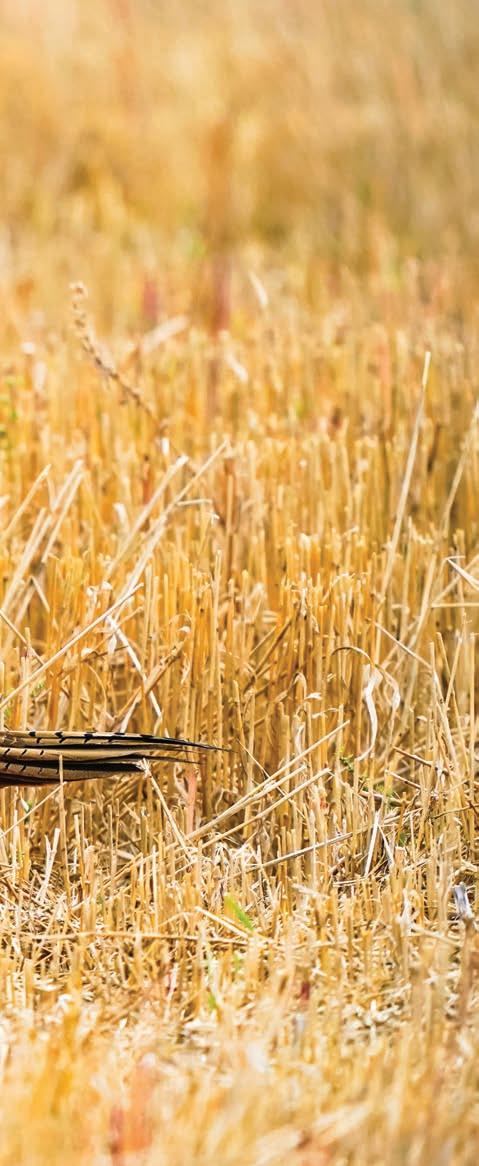
28 Buffaloberry Patch
33
Back Cast
North Dakota OUTDOORS is published 10 times a year, monthly except for the months of April and September. Subscription rates are $10 for one year or $20 for three years. Group rates of $7 a year are available to organizations presenting 25 or more subscriptions. Remittance should be by check or money order payable to the North Dakota Game and Fish Department. Indicate if subscription is new or renewal. The numbers on the upper right corner of the mailing label indicate the date of the last issue a subscriber will receive unless the subscription is renewed.
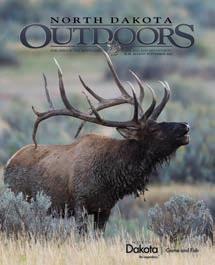
Permission to reprint materials appearing in North Dakota OUTDOORS must be obtained from the author, artist or photographer. We encourage contributions; contact the editor for writer and photography guidelines prior to submission.
The NDGFD receives Federal financial assistance from the US Fish and Wildlife Service and the US Coast Guard. In accordance with Title VI of the Civil Rights Act of 1964, Section 504 of the Rehabilitation Act of 1973, Title II of the Americans with Disabilities Act of 1990, the Age Discrimination Act of 1975, and Title IX of the Education Amendments of 1972, the NDGFD joins the US Department of the Interior and its Bureaus and the US Department of Homeland Security in prohibiting discrimination on the basis of race, color, national origin, age, disability, sex (in education programs or activities) and also religion. If you believe you have been discriminated against in any program, activity, or facility as described above, or you desire further information, please write to: ND Game and Fish Department, Attn: Chief of Administrative Services, 100 N. Bismarck Expressway, Bismarck, ND 58501-5095 or to: Office of Civil Rights, Department of the Interior, 1849 C Street, NW, Washington, DC 20240.
AUGUST-SEPTEMBER • NUMBER 2 • VOLUME LXXXVI ■ Editor: Ron Wilson ■ Graphic Designer: Kristi Fast ■ Circulation Manager: Dawn Jochim
Front Cover Bull elk
badlands.
CONTENTS
in rut in the
Photo by Jesse Kolar, Dickinson.
My 2 Cents
By Jeb Williams, Director
As our memories of summer quickly transition into fall, a unique and time-honored tradition comes alive in North Dakota. Nestled within our diverse landscapes, the fall hunting season signals both seasoned enthusiasts and newcomers alike to go outdoors where our focus shifts to hunting birds and big game and less about our daily screen time.
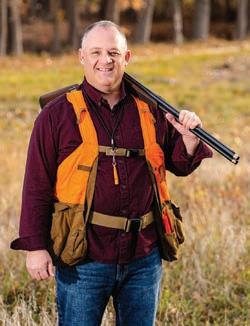
With our state’s various habitats, teeming wildlife populations, and a deeply ingrained hunting culture, North Dakota transforms into a haven where the thrill of the chase converges with the beauty of fall. From the noisy flush of a rooster to the distant call of waterfowl, the fall hunting season is more than an outdoor pursuit — it’s a celebration of tradition and camaraderie.
Hunting plays a significant role in North Dakota’s economy, contributing in various ways to the state’s financial well-being and overall livelihood. The quality-of-life component associated with fall pursuits is the very reason that keeps, and attracts, people here. Continuing to collaborate by maintaining existing partnerships and working to create new ones are the keys to keeping our outdoor heritage alive and well.
Our fall outlook edition explores into the core of the fall hunting season, where adventure meets conservation, heritage meets opportunity, and nature’s spectacle unfolds against the backdrop of the changing seasons. Where some expectations are met, and some are not.
As usual, the fall hunting outlook is promising. Not to say that all species and populations aren’t experiencing some challenges, because they are thanks to a record setting winter that wasn’t easy on any of our wild critters. With our diverse range of game species, stunning natural landscapes, and strong commitment to safe and responsible hunting, the state offers a unique opportunity for hunters to connect with friends, embrace tradition and create lasting memories.
I hope you have a safe and enjoyable fall.
2 ■ ND OUTDOORS ■ AUGUST-SEPTEMBER 2023

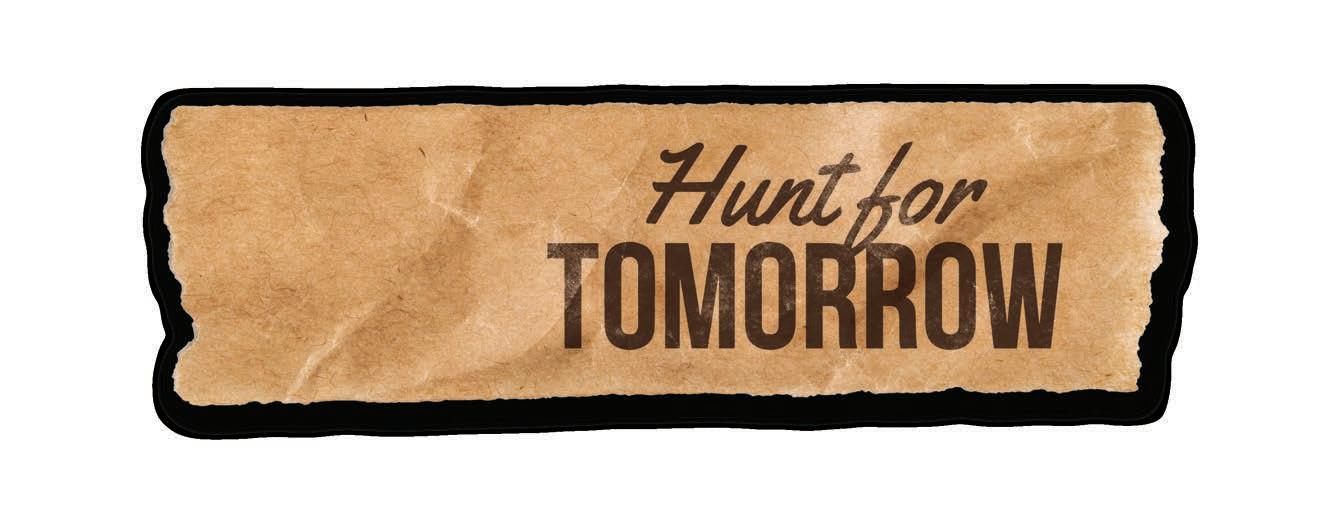
The future of Hunting Depends on our Actions Today gf.nd.gov/hunt-for-tomorrow
By Casey Anderson
Man, the countryside really greened-up this spring. North Dakota’s landscape and available habitat look impressive.
As winter finally broke, the token ring-necked roosters took to the high ground on my driveway to meet for their spring ritual. I couldn’t help but wonder if they were thinking the same thing as my neighbor and me: “Well, we survived winter, but that sucked.”
While it’s easy to forget about winter when it looks this nice out, we need to realize that it influenced wildlife and will for some time. Mother Nature pointed out pretty clearly this winter that habitat is in short supply across much of North Dakota. Populations that were impacted obviously were short on winter habitat, but time will show that all habitats are in short supply as populations will be slow to rebound. That being said, habitat available on the landscape today looks pretty darn good with the welcome moisture winter left and timely spring rains that many received.
With winter being as harsh as it was, it didn’t have the same effect on all wildlife equally.
In the big game realm, deer took it the hardest. Game and Fish Department biologists and pilots got a firsthand look as they completed a lot of aerial surveys this winter because snow conditions allowed. And the survey data showed a reduction in deer numbers, resulting in a license allocation reduction by more than 10,000 licenses.

Elk, moose and bighorn sheep have an easier time navigating bad winters and their populations held on pretty well. As I write this, Department crews are in the air once again looking at the pronghorn populations to determine their status moving forward. Of course, the harshness of winter will have a negative influence on fawn production for all big game species, and it’s just a matter of what extent that impact will be.
On the upland game side of things, we have been pleasantly surprised so far by their winter survival. Our
4 ■ ND OUTDOORS ■ AUGUST-SEPTEMBER 2023
early spring counts have indicated an increase across almost all species when compared to 2022. And in those areas where quality habitat is available, we should be looking at some good nesting and brood rearing opportunities.
Also of note, the Department has a unique wild turkey study going on which will give us some good information moving forward on fine-tuning our management of this species.
Waterfowl are certainly dependent on the water on the landscape. Not just big water, but the small wetlands that go dry periodically yet play a significant role in the life cycles of ducks and geese. Water conditions started out pretty good and if nesting and brood rearing don’t have any setbacks, we should be in decent shape. Waterfowl can respond quickly to habitat, but with the reduction in nesting and brood rearing habitat over the last number of years, some populations of duck species are not bouncing back like we would like. We’ll see if that changes in summer.
As a wildlife biologist and hunter, I long for the days I can try to figure out how to take advantage of all the extra hunting opportunities when populations are high. However, I will still be the guy who harps on the need for habitat and habitat improvements for the rest of my career.
Knowing that, the Department is working to develop programs and initiatives to help this along. Also, we are looking for ways these habitat features on the landscape can be involved in an agricultural system. This means those people doing the habitat work on their land find it beneficial for their operations for reasons other than just wildlife. I believe this is the best way to maintain the longevity of these important habitat features.
All in all, things look to be OK as far as opportunities on the landscape to get out and enjoy fall hunting. Your exact critter of preference might be tougher to find, but I would encourage all to try adding something new to your hunting bag this year if your number one option isn’t plentiful. Who knows, it may become your next annual hunting pursuit.
Good luck and happy hunting.
CASEY ANDERSON is the Game and Fish Department’s wildlife division chief.
UPLAND AND SMALL GAME
RING-NECKED PHEASANTS
Opens: Oct. 7
Closes: Jan. 7, 2024

Daily Limit: 3
Possession Limit: 12
Shooting Hours: Half-hour before sunrise to sunset.
While North Dakota’s pheasant population had to endure a severe winter in 2022-23, with most of the state receiving more than 100 inches of snow, the results of this spring’s crowing count survey surprisingly showed higher numbers of breeding roosters throughout the entire pheasant range. The number of roosters heard calling was up anywhere from 10-38% throughout the state’s good pheasant range, which reinforces Department results from last summer’s roadside brood counts that showed improved production of all upland birds.

Cover for nesting hens was above average in spring due to the excess of moisture from snowmelt and timely rains. Habitat was lush and green for early nesting attempts to be successful.
As of this writing in mid-August, biologists continue to conduct late summer roadside brood counts, and preliminary numbers indicate hunters will see an increased number of birds this fall compared to 2022.
As always, hunters need to be mobile and willing to move to different locations to find localized optimal hunting opportunities. It’s expected the northwestern and southwestern parts of the state will offer the best hunting opportunities this fall.
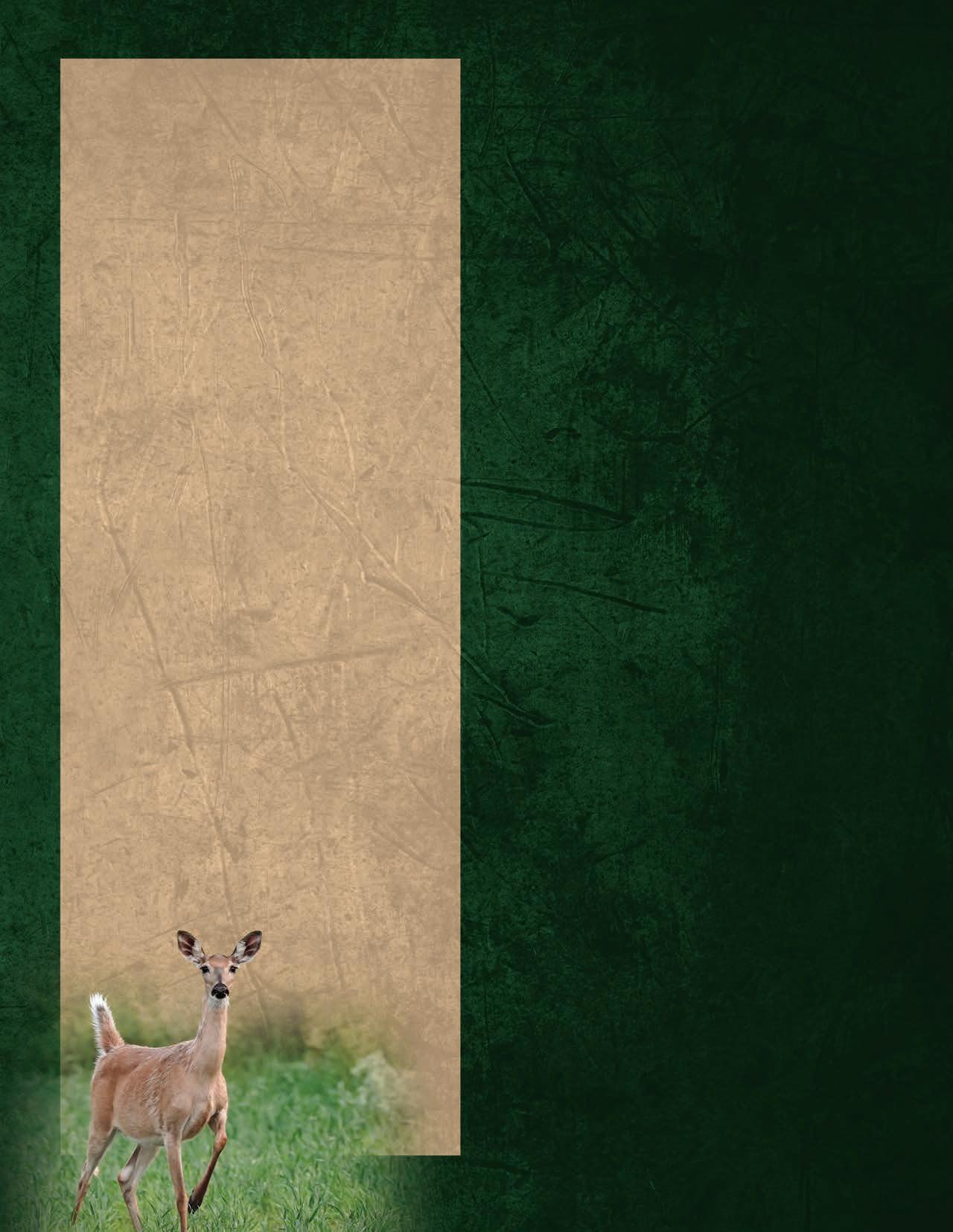 Rodney Gross, Upland Game Management Biologist, Bismarck
White-tailed deer.
Rodney Gross, Upland Game Management Biologist, Bismarck
White-tailed deer.
ND OUTDOORS ■ AUGUST-SEPTEMBER 2023 ■ 5
Ring-necked pheasant.
YOUTH PHEASANT

(For legally licensed residents and nonresidents ages 15 and younger.)
Opens: Sept. 30
Closes: Oct. 1
Daily Limit: 3
Possession Limit: 6
Shooting hours: Half-hour before sunrise to sunset.
RUFFED GROUSE
Opens: Sept. 9
Closes: Jan. 7, 2024
Daily Limit: 3
Possession Limit: 12
Shooting Hours: Half-hour before sunrise to sunset.
This year Department personnel were unable to conduct ruffed grouse surveys in the Pembina Hills due to road closures from late snow depths. However, biologists conducted surveys in the Turtle Mountains and documented a 46% increase from 2022 in the number of drums heard.
The Turtle Mountains has not had a peak in ruffed grouse since 2009-10, but this is the third year in a row with increases in the number of drums heard per stop. The Pembina Hills had a recent peak in 2020, and hunters reported seeing fair numbers in 2022.

WILD TURKEYS
Opens: Oct. 14

Closes: Jan. 7, 2024
Shooting Hours: Half-hour before sunrise to sunset.
The turkey population in many of North Dakota’s hunting units has been higher than normal the past few years due to increased production in the western half of the state. Last year, conditions were favorable for a successful turkey hatch, and Department surveys showed that.


Turkeys showed good production last spring, coupled with a high breeding population of hens, so fall numbers were higher in parts of the state. The eastern part of the state has seen decreasing numbers of birds the last few years in response to the loss of quality turkey habitat. Early reports from brood surveys showed a slight increase in the number of turkey broods on the ground in the west. It’s expected turkey production this year will be similar to 2022.
The Department increased licenses for wild turkeys slightly this fall in an attempt to give hunters more opportunities in areas where turkey populations are too high for management goals. The central and west-central parts of the state along river corridors will provide some of the better turkey hunting opportunities in the state this fall.
Rodney Gross
Ruffed grouse are an uncommon grouse in North Dakota because they live almost exclusively in aspen forests. They are only found in the Turtle Mountains and Pembina Hills. Although there was a small population in the J. Clark Salyer Wildlife Refuge (McHenry County), biologists have not heard ruffed grouse there since 2006.
6 ■ ND OUTDOORS ■ AUGUST-SEPTEMBER 2023
Jesse Kolar, Upland Game Management Supervisor, Dickinson
SHARP-TAILED GROUSE

Opens: Sept. 9
Closes: Jan. 7, 2024
Daily Limit: 3
Possession Limit: 12
Shooting Hours: Half-hour before sunrise to sunset.
The sharp-tailed grouse index (weighted average by area surveyed) for 2023 was unchanged statewide from 2022, but southwestern North Dakota (up 19%) carried the rest of the state (minus 15% in the Prairie Pothole district, minus 3% in the Drift Prairie and minus 21% at the Red River Valley/Grand Forks district).
Declines in eastern North Dakota were likely due to the prolonged winter, but the declines may be exaggerated due to poor access. Many of our survey blocks were inaccessible during the peak lekking period due to lingering snow.
Department reproduction surveys are showing more broods and/or larger brood sizes in all districts (up 14% so far). Conditions during roadside brood routes have been excellent this year, which contributes to seeing more birds, but the average brood size and chick-to-adult ratios are not as affected by conditions, so biologists are optimistic looking at a 14% increase in brood size and 1.6 chicks per adult grouse.
Similar to 2022, nesting conditions were favorable this year, but unlike 2022, biologists were seeing older chicks on the earlier brood routes, and it appears the hatch was earlier. Since chick survival increases with age, we are optimistic that reproduction should more than make up for any regional declines observed during our spring surveys.
Statewide, sharptail populations continue rebounding from lows in 2017-18, and they are just about back to or above the 10-year average across the state.
Sharptails nest almost exclusively in native prairie, pastures and planted grasses, so even though they move between nesting season and fall, the best places to find them are in areas near grasslands resembling native prairies. In the fall they can often be found in shrub patches on hillsides, alfalfa fields, sunflower fields and near harvested canola fields.
Jesse Kolar
HUNGARIAN PARTRIDGE
Opens: Sept. 9
Closes: Jan. 7, 2024
Daily Limit: 3
Possession Limit: 12
Shooting Hours: Half-hour before sunrise to sunset.
While the Department does not have a spring index for partridge, the numbers continue to surprise biologists with high rates of reproduction based on late summer roadside counts. The statewide average brood size by mid-August was around 11 chicks per brood, and 2.8 chicks per adult. Partridge reproduction has been above average for the past five years, and hunters, farmers, ranchers and others have commented on how good their numbers are looking.
Hunters rarely go “partridge hunting,” but similar to last year, it’s possible that upland hunters could expect to put up a covey of partridge every 1-2 days. These numbers are not quite what they were in the 1980s and early 1990s, but they continue to be higher than the past 20 years.
Partridge overlap with pheasants and sharp-tailed grouse in North Dakota, but their preferred habitat is weedy edges, so focus on rock pile islands in the middle of harvested fields, lone trees or shrub patches in ditches, field edges, fence lines and so on.


Jesse Kolar
TREE SQUIRRELS
Opens: Sept. 9
Closes: Feb. 29, 2024
Daily Limit: 4
Possession Limit: 12

Shooting Hours: Half-hour before sunrise to sunset.
Tree squirrels may be taken statewide with shotguns, rimfire, pre-charged pneumatic air guns and muzzleloading firearms, or with bows and arrows legal for taking upland game.
ND OUTDOORS ■ AUGUST-SEPTEMBER 2023 ■ 7
BIG GAME
WHITE-TAILED DEER
Archer Opens: Sept. 1.
Archery Closes: Jan. 7, 2024
Youth Gun Season Opens: Sept. 15
Youth Gun Season Closes: Sept. 24
Regular Gun Season Opens: Nov. 10
Regular Gun Season Closes: Nov. 26
Muzzleloader Opens: Dec. 1
Muzzleloader Closes: Dec. 17
The Game and Fish Department made available 53,400 licenses for the 2023 deer gun hunting season, a decrease of 10,800 following a brutal winter that arrived in November and hung around until April.
The statewide hunter success rate in 2022 was 53%, which was 4% lower than 2021 and below the goal of 70%. Low hunter success was likely due in large part to high winds and blizzard conditions during the first two weekends of the season.
Department biologists conducted aerial surveys on all hunting units in the state during the winter of 2023. Overall, deer numbers were up in the south central portion of the state and generally down for much of the remainder of the state. The Wing-Tuttle monitoring block (units 2J1 and 2J2) was flown in January and again in April and deer numbers had declined by 53% during that time-period.
With lower deer numbers, biologists made what might be perceived as modest reductions in licenses numbers. State Century Code requires that all landowners with more than 150 acres are entitled to receive a deer license, and in 2023 it was anticipated about 12,300 landowners would request a deer gun license. Knowing that gratis hunters tend to be less successful, and to ensure that licenses were available to non-gratis hunters, an overall reduction of 17% was made.
Licenses made available in some units may be perceived by some to be higher than appropriate. Deer hunting unit 2E might serve as an example where 300 (21%) fewer licenses were made available; of the 1,100 deer gun licenses made available in
2023, it was anticipated 640 would go to gratis hunters.


A total of 24 deer harvested in 2022-23 tested positive for chronic wasting disease, with CWD being detected for the first time in four hunting units (3A3, 3E1, 3F1 and 4F). From the 2022 hunter-harvested surveillance, CWD positive deer were also detected in 3A1 (eight mule deer), 3A3 (one mule deer), 3B1 (one mule deer), 3E1 (one mule deer), 3E2 (one mule deer), 3F1 (one mule deer), 3F2 (seven mule deer and one white-tailed deer), 4B (two mule deer) and 4F (one mule deer).
Surveillance will continue in these units to better understand CWD prevalence. As a result, this altered deer management strategies in these and surrounding units. The goal is to minimize the CWD prevalence rate and reduce the spread of the disease outside infected units; therefore, a more aggressive harvest strategy remains in parts of the state. Baiting restrictions for deer now include hunting units 1, 2B, 3A1, 3A2, 3A3, 3A4, 3B1, 3C, 3D1, 3D2, 3E1, 3E2, 3F1, 3F2, 4A, 4B, 4C, 4D, 4E and 4F.
Quality deer habitat is not as abundant as in the past, which has limited the potential for population recovery, particularly in the eastern third of the state. This is due in part to these hunting units having lost more than 70% of CRP grass cover. If CRP contracts continue to expire, by 2026 we will have lost 85% of the once 3.4 million acres present in 2007.
Landowners interested in having more antlerless deer harvested are encouraged to call the Game and Fish at 701-3286300, and Department personnel will direct the number of doe hunters that landowners are comfortable hosting.
A summary of deer licenses for 2023:
• Any Antlered licenses decreased by 3,650.

• Any Antlerless licenses decreased by 3,050.
• Antlered white-tailed deer licenses decreased by 300.
• Antlerless white-tailed deer licenses decreased by 300.
• 1,022 muzzleloader licenses available in 2023 – 511 antlered white-tailed deer licenses and 511 antlerless white-tailed deer licenses. This is a decrease of 145 muzzleloader licenses from 2022.

• 160 “I” licenses available for the youth deer hunting season, a decrease of 145 from 2022. “I” licenses are limited in number for units 3B1, 3B2 and 4A-4F, and are valid for any deer. There are unlimited “H” youth deer hunting licenses valid for any deer statewide except antlered mule deer in the above restricted units.
• 862 nonresident any deer archery licenses available in 2023, up 52 from 2022. The number of nonresident any deer archery licenses will be 337 in 2024.
• Residents ages 11, 12 and 13 who hold a statewide antlerless white-tailed deer license are no longer restricted to the youth deer season. This license is now valid during the regular deer gun season.
Biologist, Bismarck
Bill Jensen, Big Game Management
8 ■ ND OUTDOORS ■ AUGUST-SEPTEMBER 2023
Mule deer buck.
MULE DEER
Archery Opens: Sept. 1
Archery Closes: Jan. 7, 2024
Regular Gun Season Opens: Nov. 10
Regular Gun Season Closes: Nov. 26
Mule deer declined across the western edge of the state following extreme winter conditions that started in November and lasted into April. The 2023 spring index for mule deer in the badlands was 29% lower than the 2022 index and 5% below the long-term average. This was the lowest spring index since 2014.
Consequently, licenses were significantly reduced for 2023. The Game and Fish Department made available 1,600 antlered licenses and 650 antlerless licenses in 2023, which is 3,500 fewer licenses than 2022.
A mule deer buck license remains one of the most difficult licenses to draw but for those lucky few, it should result in a very high-quality hunt. Hunter success for mule deer buck hunters was 64% in 2022.

There remain many challenges facing the future population recovery of mule deer in the badlands. Encroachment of juniper in mule deer habitat, direct and indirect habitat loss due to oil development, predators and weather, including extreme winters, are all challenges facing long-term population recovery of mule deer in the badlands.
Bruce Stillings, Big Game Management Supervisor, Dickinson
PRONGHORN
Archery Only Opens: Sept. 1
Archery Only Closes: Sept. 24
Gun/Archery Season Opens: Oct. 6
Gun/Archery Season Closes: Oct. 22
North Dakota hunters will have significantly fewer opportunities to hunt pronghorn this year due to a large population decline following one of the state’s most extreme winters. Significant snowfall fell in early November and winter conditions that persisted into April put extreme stress on the population. Losses due to malnutrition were significant based on results from the Department’s 2023 aerial survey.
Biologists conducted aerial surveys of 13,340 square miles
Pronghorns.
in early July and found that the number of pronghorns in the state decreased by 40% from last year. Pronghorn reductions followed the same pattern as mule deer where animals in the northern most range experienced the largest declines. Pronghorn declines ranged from 60% in the North Missouri management region to 15% in Western Bowman management region.
The extreme winter weather also negatively affected fawn production in summer with 43 fawns per 100 does observed during the aerial survey. This was the second lowest year of fawn production on record.
Pronghorn hunting licenses and open hunting units were reduced to account for this change in the population. Hunting units 2A, 2B, 3A, 3B, 4A, 4C, 5A and 7A are open in 2023. The remaining hunting units are closed due to low population levels not able to support a harvest at this time.

The Department made available 420 licenses in 2023, 1,550 fewer than 2022. Lottery licenses can be used during the archery season (Sept. 1 (noon) – Sept. 24) with archery equipment or during the rifle season (Oct. 6-Oct. 22) using legal firearm or archery equipment.

The 2022 season was successful with 1,650 hunters harvesting 1,212 pronghorns for a success rate of 74%.
Bruce Stillings
BIGHORN SHEEP
For season details, refer to the Game and Fish Department website, gf.nd.gov, or the 2023 bighorn sheep, elk and moose hunting guide.
The North Dakota Game and Fish Department’s 2022 bighorn sheep survey, completed by recounting lambs in March, revealed a record 347 bighorn sheep in the grasslands of western North Dakota, up 4% from 2021 and 15% above the five-year average. The count surpassed the previous record of 335 bighorns in 2021.
Altogether, biologists counted 96 rams, 206 ewes and 45 lambs. Not included are approximately 40 bighorn sheep in the North Unit of Theodore Roosevelt National Park and bighorns introduced to the Fort Berthold Indian Reservation in 2020.
Big game biologists were pleased to see an increase in the survey for the fifth consecutive year.
The northern badlands population increased 4% from 2021 and was the highest count on record. The southern badlands population was unchanged at the lowest level since bighorns were reintroduced there in 1966.
Biologists noted they were encouraged to see the count of adult rams down just slightly from last year, and adult ewes were at record numbers. Unfortunately, following a record summer count of lambs, winter survival was only 54%, the lowest level on record and well below the longND OUTDOORS ■ AUGUST-SEPTEMBER 2023 ■ 9
term average. The lamb recruitment rate was also near a record low. Nearly six months of harsh winter conditions was the likely cause of poor winter survival of lambs.
Department biologists count and classify all bighorn sheep in late summer, and then recount lambs the following March as they approach 1 year of age to determine recruitment.
Department staff, in conjunction with biologists from the Three Affiliated Tribes Fish and Wildlife Division, also reported the bighorn sheep translocated in January 2020 from Rocky Boy’s Reservation in Montana to the Fort Berthold Reservation performed exceptionally well their third year in the state, as the population has nearly tripled.
There are currently about 470 bighorn sheep in the populations managed by the North Dakota Game and Fish Department, National Park Service and the Three Affiliated Tribes Fish and Wildlife Division. The next benchmark is 500 bighorns in the state, which seemed improbable just a few years ago.
A bighorn sheep hunting season is open in 2023 with six licenses — five lottery and one auction. Game and Fish issued five licenses in 2022 and all hunters were successful in harvesting a ram.
Brett Wiedmann, Big Game Management Biologist, Dickinson
MOOSE

For season details, refer to the Game and Fish Department’s website, gf.nd.gov, or the 2023 bighorn sheep, elk and moose hunting guide.
The number of once-in-a-lifetime licenses for moose was reduced in 2023 for this popular big game species. The reduction was due to an observed decrease in the population based on winter aerial surveys, a decrease in hunter success and a winter tick outbreak the previous spring that impacted the population.
The reductions are from the northwest region for moose management units M9, M10 and M11. The number of moose licenses was unchanged for moose units M6 and M8 based on a stable population and good hunter success. The boundary for moose unit M6 was expanded to include the rest of the state. This expansion will provide additional opportunities for moose hunting in those areas of the state where moose have been observed for the past several years.
Licenses in unit M5 increased slightly due to a stable population and several consecutive years with all licenses being filled in the unit. Numbers of moose continue to remain lower in historical hunting units in the Turtle Mountains, Pembina Hills and along the Red River corridor. Moose unit M1C, located in the Pembina Hills region, has been closed since 2006 and will remain closed again this year.
Moose unit M4, which encompasses the Turtle Mountains, was closed in 2013 and will also remain closed this fall.
Game and Fish issued 257 licenses for 2023. Expectations for the season are high as success for moose historically runs above 90%.
Jason Smith, Big Game Management Biologist, Jamestown
ELK

For season details, refer to the Game and Fish Department’s website, gf.nd.gov, or the 2023 bighorn sheep, elk and moose hunting guide.
North Dakota’s 2023 elk season features an increase in licenses from 2022. The primary increase in licenses was for units E1W and E1E in response to an increasing elk population in those areas and landowner tolerance concerns.
Licenses in elk units E2, E3, E4 and E6 will remain the same as 2022. Elk numbers in these units appear stable based on aerial surveys of core habitat and minimum counts of winter herds.

Game and Fish issued 603 licenses in 2023. Elk hunting in North Dakota can be challenging, both mentally and physically. Although high compared to other western states, success rates for North Dakota elk hunters averaged just over 60% the past five years. Antlerless licenses are easier to draw but are the most difficult to fill. Hunters with antlerless licenses should be prepared for a challenging hunt, with many days in the field. The season outlook for 2023 is expected to be good, with success similar to previous years.
As always, making landowner contacts and preseason scouting is recommended and essential to a successful elk hunt.
Bull elk.
10 ■ ND OUTDOORS ■ AUGUST-SEPTEMBER 2023
Jason Smith
Canada geese.

MIGRATORY BIRDS


While North Dakota wetlands dried considerably during late summer and fall of 2022, habitat conditions improved significantly in 2023 following abundant snowfall throughout winter and widespread rain in early May. Those areas in the state most influenced by this moisture held the best potential for breeding ducks.

The Department’s 76th annual breeding duck survey conducted in May showed an index of 3.4 million ducks in the state. Wetland conditions across the state during the survey varied from fair to excellent, logging the seventh highest wetland index in the history of the survey. Overall, this year’s breeding duck index was the 23rd highest in the 76 years of the survey, nearly identical to last year, and 39% above the long-term average.
With the exception of blue-winged teal, mallards and scaup, all of North Dakota’s primary breeding duck species had indices that increased from what was observed in 2022. Mallards were down 10% from their 2022 estimate and represented their 27th highest index on record. Green-winged teal increased 71%, while wigeon and pintails increased 58% and 47%, respectively. Other species’ indices increased from 12% (shovelers) to 19% (canvasbacks).
Most species’ indices remained above their 75-year averages. However, some species are still at, or below their longterm average, most notably pintails (minus 0.4%) and scaup ( minus 20%). Indices above the long-term average ranged from plus 21% (wigeon) to plus 112% (redheads); mallards were 32% above their long-term average.
After two very wet springs, the number of broods observed during the Department’s July brood survey was up substantially (80%) from last year’s count and 88% above the 1965-2022 average. The average brood size was 6.54 ducklings, down 9% from last year’s estimate. Diving ducks, which nest over water, had a banner year with record numbers of broods observed for canvasbacks and redheads.
Overall, diving ducks comprised about 22.1% of the broods observed this year, compared to the long-term average of 8.6%.
Following the seventh highest wetland index on the May survey, North Dakota’s landscape dried up considerably following another very wet spring. July wetland counts were down 33% from last year, and 25% below the long-term average. After a wet start to May, precipitation subsided considerably. Duck brood habitats dwindled during summer, with the most drying occurring in the northern tier of the state.
Overall, the fall flight forecast of ducks from North Dakota is up 23% from last year and is the 15th highest fall flight from the state on record.
Numbers of temperate-breeding Canada geese, Western Prairie Canada geese and arctic nesting Tallgrass Prairie Canada geese, snow geese and Ross’s geese all remain high, despite declines in abundance of central arctic light geese in recent years. Production of Canada geese in the state was strong this year, and large-type Canada geese in the state continue to be abundant. Unusually warm weather in the arctic created some uncertainty around goose production, but limited observations indicated average production overall. More is expected to be learned about these populations after monitoring efforts during late summer and early fall.
Hunters should expect favorable conditions for waterfowl hunting in North Dakota this year. Canada goose hunting should be good, but timing of crop harvests is always a wildcard for early season hunting. Canada geese probably won’t start grouping up and moving around much until September this year, due to late reproduction efforts and later crop harvests.
We do not expect an overly strong duck migration due to relatively dry conditions in Prairie Canada. Hunters should take advantage of early-migrants like blue-winged teal during the first two weeks of the season as teal production appeared to be good. North Dakota waterfowl hunting seasons are always affected by fall weather, and weather patterns from early to late seasons usually are not consistent from year to year. Another increase in the percentage of young birds in the fall flight this year should help hunter success.
The Department’s fall wetland survey will give one last look at wetland conditions in September.
Mike Szymanski, Supervisor, Migratory Game Bird Management, Bismarck
ND OUTDOORS ■ AUGUST-SEPTEMBER 2023 ■ 11
YOUTH WATERFOWL SEASON
(For legally licensed residents and nonresidents ages 15 and younger.)
Opens: Sept. 16
Closes: Sept. 17
Shooting Hours: Half-hour before sunrise to sunset.
Daily Limit: Ducks and geese – same as regular season.


(Does not include bonus blue-winged teal.)
SPECIAL VETERAN AND ACTIVE MILITARY WATERFOWL SEASON
(For legally licensed veterans and members of the Armed Forces on active duty, including members of the National Guard and Reserves on active duty, other than for training.)

Opens: Sept. 16
Closes: Sept. 17
Shooting Hours: Half-hour before sunrise to sunset.
Daily Limit: Ducks and geese – same as regular season
(Does not include bonus blue-winged teal.)
EARLY CANADA GOOSE HUNTING
Opens: Aug. 15 (statewide)
Closes: Sept. 7 (Missouri River Canada Goose Zone), Sept. 15 (Western Canada Goose Zone), Sept. 22 (Eastern Canada Goose Zone)
Shooting Hours: Half-hour before sunrise to sunset.
Daily Limit: 15
Possession Limit: 45
CANADA GOOSE REGULAR SEASON

Opens: Sept. 23 (residents only), Sept. 30 (nonresidents)
Closes: Dec. 29 (Missouri River Canada Goose Zone), Dec. 21 (Western Canada Goose Zone), Dec. 16 (Eastern Canada Goose Zone)
Daily Limit: 5 (Missouri River zone), 8 (all other zones)
Possession Limit: 15 (Missouri River zone), 24 (all other zones)
WESTERN ZONE
12 ■ ND OUTDOORS ■ AUGUST-SEPTEMBER 2023
EASTERN
CANADA
! ! ! ! ! ! ! ! ! ! ! ! ! ! ! ! ! ! ! ! ! ! ! ! ! ! ! ! ! ! ! ! ! ! ! ! ! ! ! ! ! ! ! ! ! ! ! ( ! ! ! ! ! ! ! . . . . £ ¤ § ! ! £ ¤ ! ( ! £ ¤ ! ! . ! £ ! ! ! ( . ! ! ! ! ! £ ¤ ! ! ! ! ! ( ! ! ! ! ! . ! ! ! ! ! ! ( ! ! ! ! ( ! ! ! . ! § ¨ ! £ £ ¤ ! £ § ! ( ! ! ! ! ! ! ! ! ( ! ! ( ! ! . ! ! ! ! ( ! ! § ! £ ! ( ! £ ! ! ! ! ( ! ! ! ! ! ! £ ! . £ ! £ ! £ ¤ ! ( ! £ ! ! ( ! £ ! ! £ ! ! ! ( £ ! ! ! ! ( ! ( ! £ ¤ ! ! ! ! ! ! . ! ! ! . . ! § £ . ! ! ! . £ ¤ . . ! ! ! ! £ ¤ £ ¤ ! ( ! ! ( £ ! . £ ¤ ! ! . . ! ! ! ! ( ! ! ! ! ! ! ! ! ( ! ! ! ! ! ! ! . ! . ! ! ! . . ! § ! ! ! ! ! ! £ ! ( ! £ £ ¤ ! . . ! £ ¤ ! ! ! £ . ! . £ ! ! ! § ¨ ! £ £ ! ! ! ! ! ! ! ! ! ! ! ! ! ! ! ! ( ! . § ! ! ! ! ( § ! ! ! ! ! ! £ ! ! ! ! . ! ! ! ! ! ! ( ! 200A 1806 1804 1804 1804 1806 1804 200A 200A 1804 1806 1806 1804 1804 94 29 29 94 94 94 94 29 29 8 40 23 66 18 65 13 46 3 3 200 200 83 23 8 2 15 32 52 24 30 34 2 17 11 13 200 26 9 32 13 3 52 23 18 20 32 20 11 32 18 11 11 127 13 1 18 18 20 20 17 30 3 32 38 32 18 200 18 15 2 81 66 81 18 32 5 32 32 35 1 32 1 45 45 20 15 200 1 1 20 9 20 1 1 281 13 1 281 11 1 11 56 13 34 46 46 56 30 281 36 200 52 30 281 15 281 57 19 2 19 30 66 281 30 30 281 5 66 3 2 3 19 36 3 14 3 83 34 13 13 3 3 11 6 6 24 6 83 25 36 41 83 200 41 53 41 41 52 83 14 14 43 83 5 256 83 28 37 200 200 31 31 49 49 31 21 49 8 8 8 37 37 8 28 28 28 5 8 50 22 23 73 22 200 200 22 22 21 8 22 8 22 12 67 21 85 85 23 42 85 5 5 50 2 58 200 85 68 68 16 16 12 85 50 40 40 50 40 5 1 20 66 66 17 17 1 1 14 15 32 200 18 46 18 27 27 32 46 5 5 14 52 53 21 17 4 200 60 42 50 89 48 5 18 Manning Washburn Stanley Bowbells Carson Linton Towner Bottineau Cando Lakota Crosby Amidon Bowman Hettinger Mott Center Grafton Devils Lake Rugby Mc Clusky Carrington Cooperstown Grand Forks Finley Valley City Ashley Napoleon Ellendale Forman Beach Mandan Cavalier Langdon Hillsboro Fessenden New Rockford Minnewaukan Rolla Jamestown Fargo LaMoure Lisbon Bismarck Wahpeton MOUNTRAIL SIOUX BOTTINEAU MCHENRY MCLEAN BENSON RENVILLE TOWNER CAVALIER FOSTER GRIGGS STEELE PEMBINA WALSH BARNES STUTSMAN RICHLAND Steele Fort Yates Stanton MORTON VALLEY Medora STARK SLOPE BOWMAN BILLINGS GOLDEN Dickinson Watford City Williston Minot DIVIDE WILLIAMS MCKENZIE BURKE DUNN WARD MERCER OLIVER HETTINGER
ZONE
GOOSE HUNTING ZONES BRIAN HOSEK
MISSOURI RIVER ZONE
Northern pintails on the wing.
DUCKS HIGH PLAINS/LOW PLAINS UNITS
WHITE-FRONTED GEESE (Statewide)
Opens: Sept. 23 (residents only), Sept. 30 (nonresidents)
Closes: Dec. 3
Daily Limit: 3
Possession Limit: 9
LIGHT (SNOW) GEESE (Statewide)
Opens: Sept. 23 (residents only), Sept. 30 (nonresidents)
Closes: Dec. 29
Daily Limit: 50, no possession limit
Shooting Hours for all Geese: Half-hour before sunrise to 2 p.m. Exception: Shooting hours are a half-hour before sunrise to sunset on all Saturdays and Wednesdays through the end of each season. Starting Nov. 26, all-day hunting is also allowed on Sundays through the end of each season.
REGULAR DUCK SEASON
LOW PLAINS UNIT

Opens: Sept. 23 (residents only), Sept. 30 (nonresidents)
Closes: Dec. 3
Shooting Hours: Half-hour before sunrise to sunset.
HIGH PLAINS UNIT
Opens: Sept. 23 (residents only), Sept. 30 (nonresidents)
Closes: Dec. 3
Opens: Dec. 9
Closes: Dec. 31
Shooting-hours: Half-hour before sunrise to sunset.
Daily Limit: Six ducks (including mergansers), which may include no more than five mallards (two of which may be

hens), one pintail, two redheads, two canvasbacks, one scaup and three wood ducks. In addition to the daily bag limit of ducks, an additional two blue-winged teal may be taken from Sept. 23 through Oct. 8.
Possession Limit: Three times the daily limit.
SANDHILL CRANES
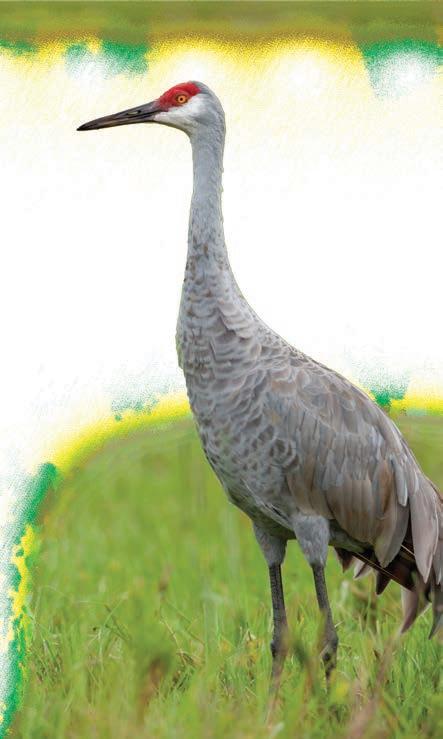
Opens: Zone 1 and 2: Sept. 16
Closes: Zone 1 and 2: Nov. 12
Daily Limit Zone 1: 3
Daily Limit Zone 2: 2
Possession Limit Zone 1: 9
Possession Limit Zone 2: 6
Shooting Hours: Half-hour before sunrise to 2 p.m. daily. The mid-continent population of sandhill cranes is in good shape heading into fall. The northern Great Plains experienced a cold start to spring this year, which slowed down the northern migration of most birds. As a result, few sandhill cranes made it north of the central Platte River valley of Nebraska where the annual spring survey is conducted. Given these conditions, a large proportion of the population was likely captured during the survey. Survey numbers have yet to be finalized for 2023, but

! ! ! ! ! ! ! ! ! ! ! ! ! ! ! ! ! ! ! ! ! ! ! ! ! ! ! ! ! ! ! ! ! ! ! ! ! ! ! ! ! ! ! ! ! ! ! ! ! ! ! ! ( ! ! . . . . . £ § ! ! £ ! ( ! £ ¤ ! ! ( . ! £ ¤ ! ( ! ! . ! ! ! ! ! ( £ ¤ ! ( ! ! ! ! ! ! ( ! ! ( ! . ! ! ! ! ! ! ! ( ! ! ! ( ! ! ( ! . ! § ! £ ¤ £ ! £ § ! ! ! ! ! ! ! ! ( ! ! ! ( ! ! . ! ( ! ! ! ! ! § ! £ ¤ ! ( ! £ ¤ ! ! ! ! ! ! ! ( ! ( ! ! £ ¤ ! . £ ! £ ¤ ! £ ! ! £ ! ! ! £ ¤ ! ! £ ! ( ! ! £ ¤ ! ! ! ! ! ! £ ! ! ! ( ! ! ! . ! ! ! . . ! ( § ¨ £ ¤ . ! ! ( ! . £ . . ! ( ! ! ( ! ! £ £ ! ! ! £ ¤ ! . £ ¤ ! ! ( . . ! ! ! ! ! ! ! ! ( ! ! ! ! ! ( ! ! ! ! ! ! ( . ! . ! ! ! ( . . ! § ! ! ! ! ! ( ! £ ¤ ! ! £ ¤ £ ! . . ! £ ! ! ! £ ¤ . ! . £ ¤ ! ! ! § ¨ ! £ ¤ £ ¤ ! ! ! ! ! ! ! ! ! ( ! ! ( ! ! ! ! ! ! . § ! ! ! ! § ! ! ! ! ! ! £ ! ! ! ! . ! ! ( ! ( ! ! ! ! ! ( ADAMS LAMOURE PIERCE RANSOM NELSON GRANT LOGAN ROLETTE BURLEIGH MCINTOSH WELLS CASS TRAILL DICKEY GRAND FORKS EMMONS SHERIDAN RAMSEY SARGENT KIDDER EDDY 200A 1806 1806 1804 1804 1804 1806 1804 200A 200A 1804 1806 1806 1804 1804 94 29 29 94 94 94 94 29 29 8 40 23 66 18 65 13 46 3 3 200 200 83 23 8 2 15 32 52 24 30 34 2 17 11 13 200 26 9 32 13 3 52 23 18 20 32 20 11 32 18 11 11 127 13 1 18 18 20 20 17 30 3 32 38 32 18 200 18 15 2 81 66 81 18 32 5 32 32 35 1 32 1 45 45 20 15 200 1 1 20 9 20 1 1 281 13 1 281 11 1 11 56 13 34 46 46 56 30 281 36 200 52 30 281 15 281 57 19 2 19 30 66 281 30 30 281 5 66 3 2 3 19 36 3 14 3 83 34 13 13 3 3 11 6 6 24 6 83 25 36 41 83 200 48 41 53 41 41 52 83 14 14 43 83 5 256 83 28 37 200 200 31 31 49 49 31 21 49 8 8 8 37 37 8 28 28 28 5 8 50 22 23 73 22 200 200 22 22 21 8 22 8 22 12 67 21 85 85 23 42 85 5 5 50 2 58 200 85 68 68 16 16 12 85 50 40 40 50 40 5 1 20 66 66 17 17 1 1 14 15 32 200 18 46 18 27 27 32 46 5 5 14 52 53 21 17 4 200 60 42 50 89 48 31 5 18 Manning Washburn Stanley Bowbells Carson Linton Towner Bottineau Cando Lakota Crosby Amidon Bowman Hettinger Mott Center Grafton Devils Lake Rugby Mc Clusky Cooperstown Grand Forks Finley Valley City Ashley Napoleon Ellendale Forman Beach Mandan Cavalier Langdon Hillsboro Fessenden New Rockford Minnewaukan Rolla Jamestown Fargo LaMoure Lisbon Bismarck Wahpeton MOUNTRAIL SIOUX BOTTINEAU MCHENRY MCLEAN BENSON RENVILLE TOWNER CAVALIER FOSTER GRIGGS STEELE PEMBINA WALSH BARNES STUTSMAN RICHLAND Steele Fort Yates MORTON VALLEY Medora STARK SLOPE BOWMAN BILLINGS GOLDEN Dickinson Watford City Williston Minot DIVIDE WILLIAMS MCKENZIE BURKE DUNN WARD MERCER OLIVER HETTINGER Carrington HIGH PLAINS UNIT LOW PLAINS UNIT BRIAN HOSEK Sandhill crane. ND OUTDOORS ■ AUGUST-SEPTEMBER 2023 ■ 13
initial reports indicate a strong survey with numbers exceeding the record-setting 2018 totals.
In addition, the three-year population index used for guiding hunting season regulations has been stable to slightly increasing for several years now. Wetland conditions throughout much of North Dakota are also in good shape, which will provide plenty of options for roosting sandhill cranes during the fall migration.
The two zone – Zone 1 west of U.S. Highway 281 and Zone 2 east of U.S. Highway 281 – structure for sandhill cranes continues. The two zones have the same season lengths (58 days) and dates but will continue to have different bag limits. Zone 1 has a daily bag limit of three cranes; in Zone 2 the daily bag limit is two. The possession limit in Zone 1 is nine cranes, and six in Zone 2.
Nonresident sandhill crane hunters can pursue sandhill cranes with either a valid nonresident small game or waterfowl license, in addition to a crane permit. Nonresident sandhill crane permits are valid for use within the dates and zones of nonresident waterfowl or small game licenses selected during purchase.
Hunters are also reminded to be sure of their target before shooting, as federally endangered whooping cranes may be present throughout North Dakota during fall. Report all whooping crane sightings to the North Dakota Game and Fish Department in Bismarck at 701-328-6300.
Andrew Dinges, Migratory Game Bird Biologist, Bismarck
DOVES
Opens: Sept. 1
Closes: Nov. 29
Daily Limit: 15
Possession Limit: 45
Shooting Hours: Half-hour before sunrise to sunset.
North Dakota has an abundant breeding population of mourning doves and based on observations throughout the state, production was fair to good this year. Weather was favorable during the nesting season, with relatively dry conditions and few severe storms, which likely led to good recruitment. The Game and Fish Department also tallies mourning doves during late summer roadside counts, but numbers have yet to be finalized. Although survey numbers are not currently available, age ratios of juvenile to adult birds captured at banding stations in the state were indicative of good production this year.
Dove hunters should find good to excellent opportunities during early September before cooler weather sets in throughout the state and pushes doves south. Hunters are encouraged to scout before the season to find the right mix of conditions that are conducive to concentrating birds. Hunters should look for areas with abundant harvested small grain or
oil-seed fields that are also near shelterbelts or other diverse stands of trees. Doves also need to be within a few miles of water sources. Despite late planting, harvest of small grains and oil-seed crops are projected to be near average, so hunters should have plenty of places to choose from in September for field hunting.
Eurasian collared doves continue to expand throughout the state and are found in almost every city and small town. However, these birds are not often found outside of municipalities and are rarely harvested by hunters. Nonetheless, Eurasian collared doves can be pursued during the dove season and are included with mourning doves in the daily bag and possession limits if harvested.
Some dove hunters may be contacted by the U.S. Fish and Wildlife Service to participate in a wing survey, which involves clipping one wing from each dove shot early in the season to send in for analysis. Hunters are also reminded to look for banded mourning doves in their bag and report bands directly to the Bird Banding Laboratory website at reportband.gov.
Andrew Dinges
CROWS
Fall Season Opens: Aug. 19
Closes: Nov. 6
Spring Season Opens: March 9, 2024


Closes: April 21, 2024
Daily Limit: No limit on crows.
Shooting Hours: Half-hour before sunrise to sunset. In addition to the crow season, crows may be taken when committing or about to commit depredations as specified in federal law.
SNIPE
Opens: Sept. 9
Closes: Dec. 3
Daily Limit: 8
Possession Limit: 24
Shooting Hours: Half-hour before sunrise to sunset.
WOODCOCK

Opens: Sept. 23
Closes: Nov. 6
Daily Limit: 3
Possession Limit: 9
Shooting Hours: Half-hour before sunrise to sunset.
14 ■ ND OUTDOORS ■ AUGUST-SEPTEMBER 2023
FURBEARERS

For more season details, refer to the North Dakota Game and Fish Department website, gf.nd.gov, or the 2023-24 Hunting and Trapping Guide.
Overall, furbearer populations remain relatively similar to 2022 and there are no significant changes to the furbearer regulations this fall. Harvest limits, timing of seasons and zones are all the same.

Spring surveys indicated coyotes remain the bright spot in North Dakota and were largely the most abundant furbearer seen by observers. Compared to last year, however, their numbers were relatively unchanged and even slightly below the 20-year average.
Foxes continue to be outcompeted by coyotes most places, although they are holding steady in the Prairie Pothole Region. And muskrats continue to struggle to reach higher numbers with only the eastern half of the state showing much promise where their numbers were similar to last year. Raccoons may be the highlight this season, with their survey numbers being as good as they get up here on the northern fringe of their range.
Last year, hunters and trappers took 25 bobcats (21 in Zone 1 and four in Zone 2), 21 fishers, 24 river otters and 12 mountain lions in Zone 1 (four in the earlyseason and seven in the late-season) and one mountain lion in Zone 2.
Because many furbearer species are difficult to survey due to their secretive nature and naturally low densities, we encourage anyone to report their sighting(s) of black bears, bobcats, fishers, martens, mountain lions, river otters and swift foxes.
Information about sightings can be submitted online at gf.nd.gov/hunting/furbearers/furbearer-observation.
Hunters are also reminded that only coyotes, foxes (red or gray), raccoons and beavers are allowed to be hunted at night. And the dates for hunting coyotes and foxes at night are restricted to November 27 to March 15, 2024.
Stephanie Tucker, Game Management Section Leader, Bismarck
MOUNTAIN LION HUNTING
Zone 1 (early) Opens: Sept. 1
Closes: Nov. 26

Zone 1 (late) Opens: Nov. 27
Closes: March 31, 2024
Zone 2 Opens: Sept. 1
Closes: March 31, 2024

The overall harvest limit on mountain lions in Zone 1 is once again 15, with an early season limit of eight, and a lateseason limit of seven (or three females, whichever comes first). If the early season ends before eight mountain lions are taken, a conditional season could reopen after the late season, if the late season limit is reached prior to March 25.

There is no mountain lion harvest limit in Zone 2.
Mountain lions may be hunted statewide by residents using legal firearms or archery equipment during regular hunting hours. Beginning Nov. 27, mountain lions may also be hunted by pursuing with dogs. Cable devices and traps are not allowed. The limit is one lion per hunter. Kittens (lions with visible spots), or females accompanied by kittens, may not be taken.
Hunters must either contact the local game warden or Department field office or register their harvest online via their account and make arrangements to have their lion inspected and tagged.
Mountain lion.
ND OUTDOORS ■ AUGUST-SEPTEMBER 2023 ■ 15
RIVER OTTER TRAPPING OR CABLE DEVICES
Opens: Nov. 27
Closes: March 15, 2024
Limit of one per person. Total harvest limit of 25 statewide.
Trappers must either contact the local game warden or Department field office or register their harvest online via their account to report their harvest within 12 hours and make arrangements to have their river otter tagged. For more information, see the North Dakota 2023-24 Hunting and Trapping Guide.

FISHER TRAPPING OR CABLE DEVICES
Opens: Nov. 27
Closes: Dec. 3
Open statewide except for Bottineau and Rolette counties. Limit one per person. Trappers must contact the local game warden or Department field office or register their harvest online via their account to report their harvest within 12 hours and make arrangements to have their fisher tagged. For more information, see the North Dakota 2023-24 Hunting and Trapping Guide.
BEAVER AND RACOON TRAPPING, HUNTING OR UNDERWATER CABLE DEVICES
Open: Year-round.
For more information, see the North Dakota 2023-24 Hunting and Trapping Guide.
BEAVER AND RACOON CABLE DEVICES ON LAND
Opens: Nov. 27
Closes: March 15, 2024
From March 16, 2024, through May 10, 2024, cable devices must be within 50 feet of water; must be no more than 4 inches off the ground and must have a stop restricting loop size to 12 inches or less in diameter.
Beaver dams may be dismantled when their presence causes property damage.
WEASEL TRAPPING, HUNTING OR CABLE DEVICES
Trapping Opens: Oct. 28
Hunting and Cable Devices Opens: Nov. 27
Closes: March 15, 2024

Weasels may be hunted statewide with rimfire or precharged pneumatic air guns of .22 caliber or smaller and archery equipment.
MUSKRAT AND MINK TRAPPING, HUNTING OR CABLE DEVICES
Trapping Opens: Oct. 28
Hunting and Cable Devices Opens: Nov. 27
Closes: May 10, 2024
Muskrat huts may be opened for insertion of traps or cable devices; however, the huts must be restored to their approximate original condition to prevent freeze-up.
Beginning March 16, 2024, non-floating colony traps must be under at least 2 inches of water, and trapping or using cable devices on the outside of any muskrat house or structure of any size is prohibited; traps may be placed completely inside a muskrat house or structure of any size; foothold traps must be submerged under water at all times or must have a protective covering (except when used on float sets); bodygripping traps used in water can have no more than 2 inches of the trap above the water or must have a protective covering.
Beginning May 1, 2024, float sets must have a protective covering.
Mink and muskrat may be hunted statewide with rimfire cartridges or pre-charged pneumatic air guns of .22 caliber or smaller and archery equipment.

16 ■ ND OUTDOORS ■ AUGUST-SEPTEMBER 2023
Jens Johnson with a fisher.
BOBCAT TRAPPING, HUNTING OR CABLE DEVICES
Zone 1: Nov. 11
Cable Devices Opens: Nov. 27
Closes: March 15, 2024
Beginning Nov. 27, bobcats may also be trapped using cable devices and hunted by pursing with dogs.
The pelt and carcass of each bobcat taken in Zone 1 must be presented to Department personnel for inspection and tagging prior to sale or transfer of possession, but no later than 14 days after the close of the season.
Zone 2: Nov. 27

Closes: March 15, 2024
Limit is one bobcat per person in Zone 2 and total harvest limit is eight.
In Zone 2, anyone who harvests a bobcat must either
contact the local game warden or Department field office or register their harvest online via their account to report their harvest within 12 hours and make arrangements to have their bobcat tagged.
For more information, see the 2023-24 Hunting and Trapping guide.
RED FOX, GRAY FOX, COYOTE TRAPPING, HUNTING OR CABLE DEVICES

Day Hunting and Trapping Open: Year-round Night Hunting and Cable Devices Opens: Nov. 27
Closes: March 15, 2024
Red fox, gray fox and coyote may be hunted at any hour from Nov. 27 through March 15, 2024. Any hunter who engages in the hunting of red fox, gray fox or coyote during the time from a half-hour after sunset to a half-hour before sunrise, must hunt exclusively on foot.
Hunters can use night vision, artificial light, thermal vision, and infrared light equipment during the night hunting season. Hunters are prohibited from using archery equipment (including crossbows) for night hunting until after the close of the archery deer season.
BADGER TRAPPING, HUNTING OR CABLE DEVICES
Hunting and Trapping Open: Year-round Cable Devices Opens: Nov. 27 Closes: March 15, 2024
SMALL GAME, WATERFOWL, FURBEARER REGULATIONS
North Dakota’s 2023 small game, waterfowl and furbearer regulations are set, and most season structures are similar to last year.
Noteworthy items include:
• Opening day for ducks, geese, coots and mergansers for North Dakota residents is Sept. 23. Nonresidents may begin hunting waterfowl in North Dakota Sept. 30.
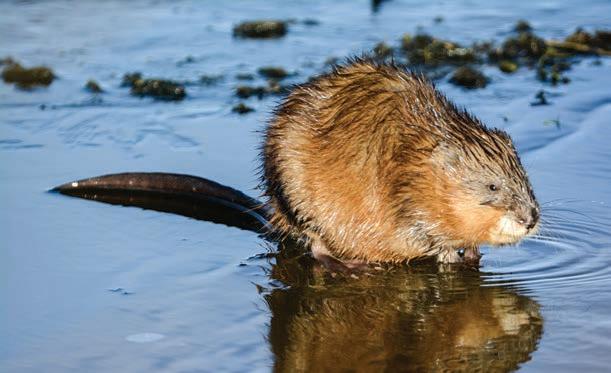
• The prairie chicken and sage grouse seasons remain closed due to low populations.
• Pre-charged pneumatic air guns are legal for taking tree squirrels.
Hunters and trappers can find the North Dakota 2023-24 Hunting and Trapping Guide, which includes upland game, migratory game bird and furbearer/trapping regulations and other information, on the Game and Fish website. Printed guides will be available at vendor locations in early September.
For a complete listing of opening and closing dates, and daily and possession limits, refer to pages 4-5 of the guide.

ND OUTDOORS ■ AUGUST-SEPTEMBER 2023 ■ 17
Muskrat.
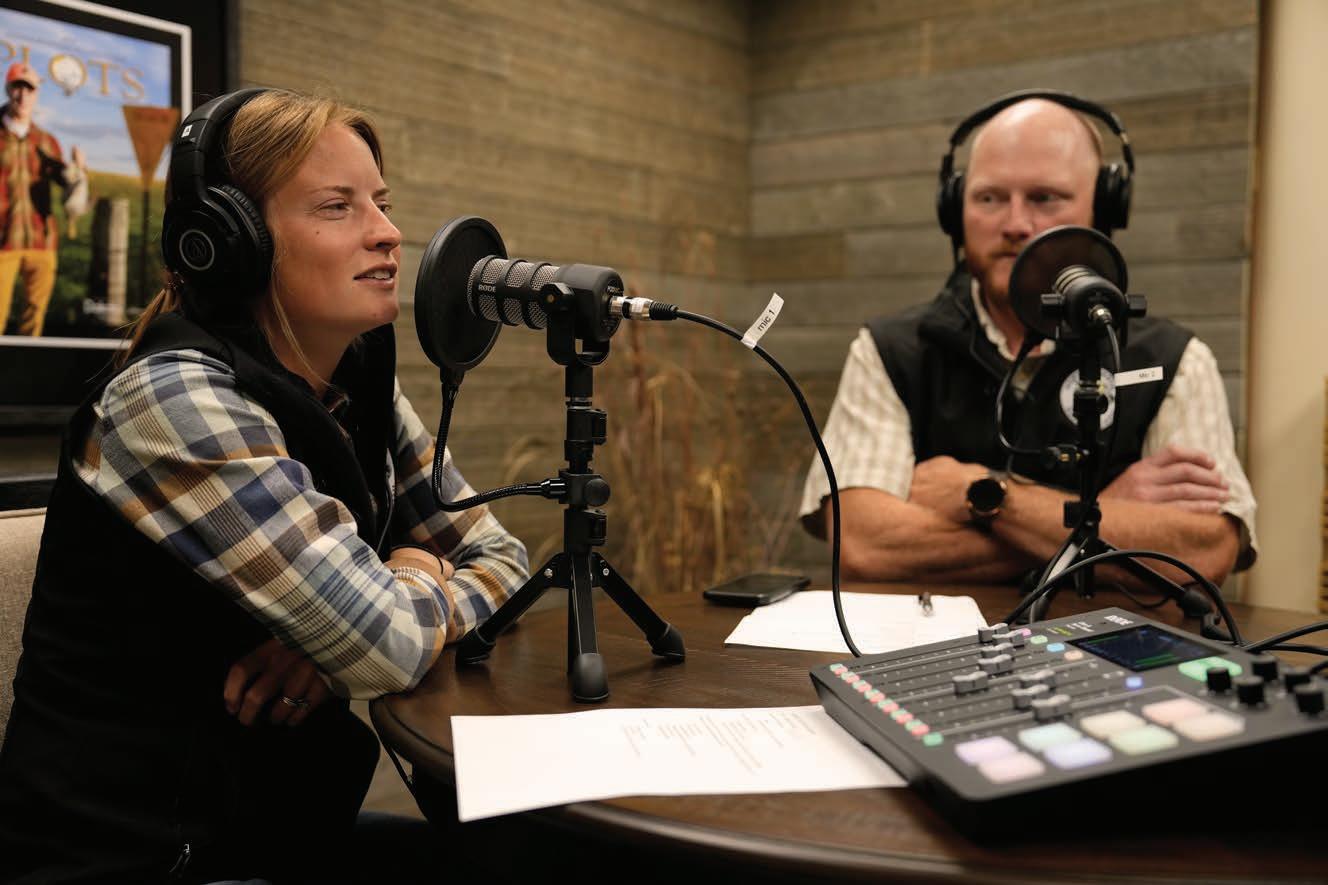


18 ■ ND OUTDOORS ■ AUGUST-SEPTEMBER 2023




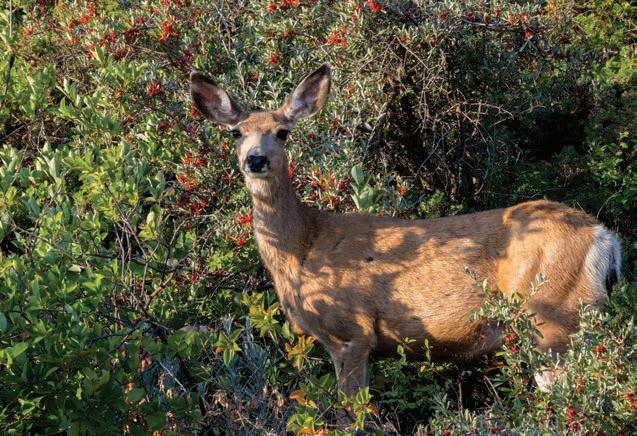
SEARCH ND OUTDOORS ON YOUR FAVORITE PODCAST PLATFORM ND podcast ND OUTDOORS PODCAST THE OFFICIAL PODCAST OF THE NORTH DAKOTA GAME AND FISH DEPARTMENT. GF.ND.GOV/NDO-PODCAST
BY: CAYLA ND OUTDOORS ■ JUNE 2023 ■ 19
HOSTED
Loss of CRP Continues to Sting
More than 800,000 Private Land Open To Sportsmen acres will be available to hunters this fall. That’s an increase of about 5,000 acres from 2022 for this walkin access program that has been a fixture on the rural North Dakota landscape for more than two decades.

Kevin Kading, North Dakota Game and Fish Department private land section leader, provided an update on the PLOTS program in mid-July knowing that the summer heat would eventually surrender to cooler temperatures and fall hunting seasons.
NDO: The acreage total is similar to the last handful of years. Is it a good thing or bad thing that those numbers have been relatively stable?
Kading: Well, we’d like to have more acres, but it’s also in our minds that 800,000-plus acres is a good thing because we’re not going backwards. It just takes that much more nowadays to maintain this many acres in the program than it did 10 years ago. Field staff put in a lot of time developing habitat, working with the landowner, which can take a lot of time. It’s not just signing an agreement and we’re on our way. It’s maybe over a two-year period sometimes ... it takes time to get those acres on the ground. It’s a good thing that we’re able to maintain those PLOTS acres, but we’re still hoping to keep growing the program, too.

NDO: What are some of the hurdles in signing up landowners to the program and increasing the acreage total?
Kading: One thing that we’ve talked about for a decade is the loss of CRP in the state. When September comes around, we’re going to be under a million acres of CRP in our state. We used to be one of the highest in the country, with 3.4 million acres. That’s a lot of habitat that’s not available anymore, which is certainly a challenge.
20 ■ ND OUTDOORS ■ AUGUST-SEPTEMBER 2023
There are changes in land ownership and people’s interests are changing, too. While there is still interest in PLOTS, some people are just deciding it’s not for them. Commodities come and go. Ag prices come and go. We can get people interested, but they’re the ones who have to make that decision. Those are continual challenges on any private land program.
There’s a workload issue that can be a hurdle, too. We’ve got around 2,800 private landowner agreements. And some of these agreements have multiple owners, which means we have to collect multiple signatures, some people are out of state or out of the country. We validate ownership to make sure they own it, make sure that we have the proper owners, make sure the proper owners are getting paid. That’s just something we have to do and that just takes time.
Our staff is busy nonstop ... there’s no real downtime anymore. They’re either working on renewing and maintaining existing agreements or searching out new prospects for the next year. While that’s a good thing, it’s certainly a hurdle because we can only do so much in a day, week or month.
NDO: In the last legislative session, lawmakers approved three new Private Land Initiative positions. One of those new positions was habitat manager. Explain the role and focus of the Department’s new habitat manager?
Kading: Like I’ve said, we’re at that point where we’re hurting for habitat in our state with the drastic decline in CRP acres, native grasslands and wetlands being converted, and on it goes. A lot of people probably don’t realize that we’ve lost 75% of our native grasslands in our state. We are a prairie state, but we don’t have a lot of prairie left, especially in the eastern part of the state. We’ve also lost a lot of our wetlands, and that equates to loss of habitat, loss of

hunting opportunities, loss of species and populations.

Knowing this, we felt that it’s time to expand our reach beyond PLOTS. We can only do so much with PLOTS. So, what we plan to do with the habitat manager position approved by legislators is develop a habitat program that can work with or without PLOTS.
It will still require reasonable public access; we wouldn’t allow any commercial fee hunting. We plan to utilize other funding sources of hunter dollars. Hunter dollars, first and foremost, are still going to be utilized for PLOTS, for hunting access and habitat on those acres. We’ll be finding other partners, finding other grants, finding other sources. We might not even be involved in making any payments, we might just be facilitating a project with a group or a partner. We know there are a lot of opportunities to do that and to expand our reach for habitat beyond PLOTS. While this may sound new, it’s something we’ve done in the past. Over the years, we’ve done different projects that are outside of PLOTS, but this will just be expanding on that a lot more.
NDO: Wildlife managers have long said there isn’t enough wildlife habitat on the landscape. The reality of that was never more evident than last winter, one of the most difficult in years. Talk about the need for habitat on the landscape and how PLOTS fits into this narrative.
Kading: That’s what we’re trying to do, whether it’s through PLOTS or outside of PLOTS … we’re trying to get more habitat on the ground. Obviously, we’ve seen a winter like we had last year. It’s tough on a lot of things. And I think what we’re going to see is just a slow rebound to some of these populations because we don’t have that habitat base out there like we’ve had in the past. It’s important that we do what we can to get more habitat out there, whether that’s
ND OUTDOORS ■ AUGUST-SEPTEMBER 2023 ■ 21
White-tailed deer.
through PLOTS or not. There’s a lot of other programs and other avenues for the Department to promote to develop and get more habitat on the landscape, to help in that rebound of deer, pheasants and other species.
NDO: Considering the moisture garnered from near record amounts of snow from last winter and timely spring and summer rains in parts of the state, how are the PLOTS tracts looking out there as we slowly slide into fall?
Kading: Where we have the habitat, where we’ve developed new habitat, where we’ve put in new grass plantings, the habitat conditions are looking pretty good. But again, there are places in the state lacking habitat altogether. And so that doesn’t help a whole lot if we don’t have any habitat there. The prairies and wetlands look pretty good right now. Of course, it’s only a guess what the rest of the summer will look like. While the spigot can shut off and things can dry up and warm up pretty quickly in North Dakota, we’re off to a really good start this summer. PLOTS is benefiting a lot of animals right now at this time of the year.
NDO: The PLOTS tracts spread across much of rural North Dakota are first and foremost under private ownership. Any advice you like to pass along to hunters frequenting these lands during North Dakota’s fall hunting seasons?
Kading: We always tell hunters to just use common sense and treat these lands as if they’re your own. While these lands are available for the public to use, they’re still under private ownership. Regardless, whether it’s a public wildlife management area or private land enrolled in PLOTS, we want it to be treated the same.
PLOTS is a voluntary program. Landowners can come into our program any time they want, but they certainly don’t have to stay in the program if they have a bad experience. Overall, we don’t have a lot of that, but there are occasionally some bad actors out there and things happen.
We encourage hunters to pick up their garbage, don’t leave shells laying around and make sure to leave gates the way you found them if there are gates on the property.
We also encourage hunters to know their boundaries. That’s certainly one thing that’s more available now with all the electronic apps, different platforms. We sign PLOTS areas, but we’re actually looking to place fewer permanent signs on the landscape just because of all the electronic features that people are using.
It’s ultimately the hunter’s responsibility to know where they’re at and know the rules. There are rules posted on our website and in the PLOTS Guide addressing what you can and can’t do on PLOTS. It’s not a free for all. For example,
shooting clay pigeons or camping is not allowed. PLOTS are for walk-in hunting access only. Anything outside of that, hunters need to get permission from the landowner.
NDO: On a more positive note, what do you hear from landowners who are supporters of the PLOTS program?
Kading: We’ve heard everything from the payments are appreciated because they help pay the taxes to they just really enjoy sharing the land. Some landowners feel an obligation to share the land and they really enjoy it because they grew up hunting and they like seeing people come out. We’ve had landowners tell us they’ve established long-term friendships with some of these people who have come to their property to hunt. They don’t have to stop in and ask permission or knock on the door, but they do to simply tell the landowner thank you, which is really nice to hear. We do hear from landowners in our program who say that they get thank you cards in the mail or someone will stop by to shake their hand and give them some fish that they caught. I think that’s pretty neat. Overall, the PLOTS program has been very well received by landowners according to the positive comments we’ve received over the years.

NDO: The Game and Fish Department has provided a printed PLOTS Guide to users on an annual basis for more than two decades, yet the demand, considering the ability to access the guide electronically, has declined over time. What are your thoughts about simply making the guide and maps available in an electronic version only down the road?
Kading: That time is coming. Everything is kind of going that paperless route, and users have the ability today to access the guide electronically. I could see us discontinuing the printed version down the road. The guide would still be available online to be printed if somebody needed that or wanted that. Most hunters are using all these different Sharp-tailed grouse.
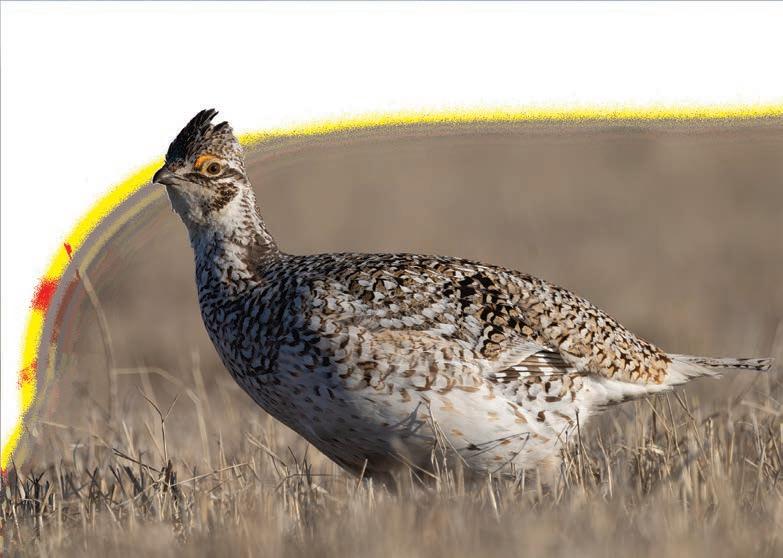
22 ■ ND OUTDOORS ■ AUGUST-SEPTEMBER 2023
HABITAT MATTERS HABITAT MATTERS
72% NORTH DAKOTA’S NATIVE PRAIRIE

Has been converted.
3.4 million
WHAT’S BEEN LOST
DEER LICENSES
55% decrease
SINCE 2007
66% decrease CRP ACRES
1 million
Economic Value of hunting to North Dakota’s economy

Harvest
60% NORTH DAKOTA’S WETLANDS
WHAT’S AT STAKE
WATER QUALITY
LOSS OF HUNTING HERITAGE
WHAT NEEDS TO BE DONE
Of the nearly 5 million natural wetland acres, 60% have been converted or lost.
GRASSLAND BIRDS


34% LOSS
50 year decline continues
With over 95% of lands held in private ownership in North Dakota investing in habitat on private lands is essential.
OWNED
gf.nd.gov/plots
TO
Pheasant
900K DOWN
300K
LAND PRIVATELY
ND OUTDOORS ■ AUGUST-SEPTEMBER 2023 ■ 23
BRING BACK HABITAT
By Ron Wilson
Notable adjustments have been made by wildlife managers in their effort to combat an always fatal disease to deer and other cervids that, at least at this point, remains rare in North Dakota.
With the state’s deer bow season opening in early September, Game and Fish Department officials announced in mid-August that big game hunters need to recognize the 2023 chronic wasting disease proclamation for baiting and transportation requirements for deer, elk and moose as a precaution against the spread of the disease.

“Unfortunately, the nature of the disease is that once it becomes established within a population and on a landscape, it’s really, really difficult to get rid of it,” said Dr. Charlie Bahnson, Game and Fish Department wildlife veterinarian. “CWD is caused by a prion, which is different from a virus or bacteria, and can’t really be deactivated … there’s not any kind of immune response. So, the first and foremost goal is to keep it out of a population. But once it’s in a population, the goal is to try to keep infection rates low.”
With that in mind, hunters need to be alerted to the following noteworthy items in the 2023 CWD proclamation:
• Whole carcasses of animals harvested in North Dakota can remain in the deer unit or may now be transported anywhere in the state. However, carcass waste must be disposed of via landfill or waste management provider. This does not apply to heads dropped at CWD collection sites or lymph nodes submitted for CWD surveillance. Taxidermists and game processors can also accept intact carcasses of animals harvested within North Dakota but assume responsibility for disposal.
• Hunters are prohibited from transporting into North Dakota the whole carcass or parts, except the lower-risk portions, of deer, elk, moose or other members of the cervid family harvested outside of North Dakota.
24 ■ ND OUTDOORS ■ AUGUST-SEPTEMBER 2023
“We’ve followed the example of a number of other states, Montana, South Dakota included, by saying that animals that are harvested within the state can go anywhere within the state, but there is a disposal requirement,” Bahnson said. “So, once you’re done processing your animal, the high-risk carcass parts, the stuff left after taxidermy or processing must end up buried via landfill. And we say via landfill, meaning either you take it to a landfill, or you get it into your waste management provider flow, which ultimately gets that stuff buried in a landfill, off the landscape. And that ultimately will prevent the chance of an animal coming into contact with that material.”
Of course, hunters can, once they’ve finished processing their animal in the field, leave the remains at the harvest site.
Also of note:
• A new management strategy that allows baiting restrictions to be removed in a unit if the number of adult deer equivalent to at least 10% of the gun licenses allocated in the unit are tested for CWD within a year, and all the results are negative. If the sampling goal is not met or CWD is confirmed in the unit, the baiting restriction will remain.

• No new units have been added to the baiting restriction list for 2023-24. Due to the timing of finalizing the proclamation, a one-year pause was placed on adding new units. Units 2K1 and 3B2 are scheduled to be added to the restriction list in 2024 due to a positive CWD detection during the 2022 hunting season within 25 miles in an adjacent unit. They will not be added if the 10% goal is reached this year and all CWD test results are negative.
Bahnson said deer can be infected in a variety of ways; through direct contact with another infected animal, or through contact with environments contaminated with bodily fluids – urine, saliva, feces – of an infected deer.
Understanding this, he said, it’s hard to justify the well-established, enhanced disease transmission risk that baiting presents.
“We know quite clearly that baiting increases the rate of those direct and indirect contacts,” Bahnson said. “We also know that our goal is to try to reduce how often animals come into contact with this disease. Baiting presents a lot of artificial, enhanced, voluntary risk.”
ND OUTDOORS ■ AUGUST-SEPTEMBER 2023 ■ 25
The Game and Fish Department will conduct surveillance of the state by region on a four-year rotation. This year, the CWD surveillance effort will consist of deer gun units in southeastern North Dakota.
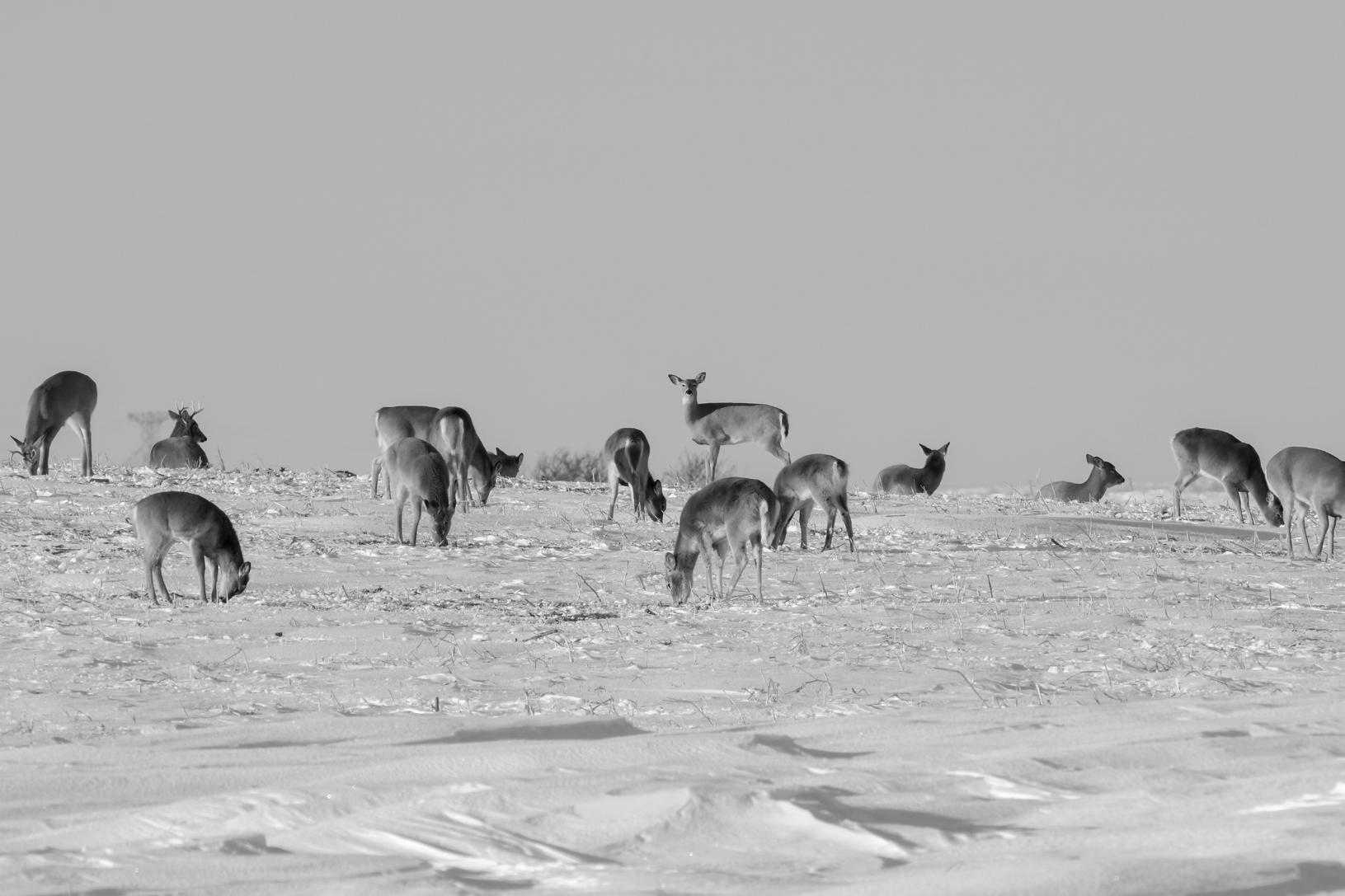
Outside of this area, hunters can still have their animal tested by taking it to a Game and Fish district office, any deer head collection site (primarily located in the surveillance area) or using a mail-in self-sampling kit. A unit outside the annual surveillance zone is still eligible to have a baiting restriction removed if the sampling goal is met or can be added as a restricted unit if a positive is found.
“One thing that we’ve been doing the last couple of years that we’re continuing to push is self-sampling. If you have a license, you can go on the Department’s website (gf.nd.gov) and request one of these self-sampling kits,” Bahnson said. “After getting the correct sample, the lymph nodes, hunters can put them in the mail, ship them to our lab, and we’ll get a test result for you. That is an option for anybody anywhere in the state. So, if you’re outside of one of our surveillance areas, you can request one of those kits.”
est certainly doesn’t stop there. Bahnson said an underutilized sample source are those deer harvested by archers. To accommodate bowhunters who harvest an animal and want to drop off the head for testing, the Department has freezers stationed in specific locations, which can be found on the Department’s website.
“But also, the self-sampling option is going to be a pretty good route for bowhunters to take as well,” he said.
ND Outdoors Podcast
Listen to the NDO Podcast on CWD management and surveillance with Dr. Charlie Bahnson, Game and Fish Department wildlife veterinarian. Listeners can find the program on their favorite podcast platform. You can also subscribe to the ND Outdoors Podcast to get text or email reminders when an episode launches.

BAI TING CURRENT LY RE STRICTED? YES NO WAS CWD FOUND OUTSIDE THE UNIT BUT WITHIN 25 MILES OF THE UNIT? BAITING RESTRICTIONS LIFTED NO CHANGES FROM PREVIOUS STATUS NO CHANGES FROM PREVIOUS STATUS NO CHANGES FROM PREVIOUS STATUS BAITING RESTRICTED NO YES NO YES NO YES WAS NUMBER OF ADULT DEER TESTED EQUIVALENT TO 10% OF LICENSE ALLOCATION IN UNIT AND WERE ALL NEGATIVE? WAS NUMBER OF ADULT DEER TESTED EQUIVALENT TO 10% OF LICENSE ALLOCATION IN UNIT AND WERE ALL NEGATIVE?
RON WILSON is editor of North Dakota OUTDOORS.
26 ■ ND OUTDOORS ■ AUGUST-SEPTEMBER 2023

ND OUTDOORS ■ AUGUST-SEPTEMBER 2023 ■ 27
BUFFALOBERRY PATCH

New Hunting, Trapping Guide

Hunters and trappers can find the North Dakota 202324 Hunting and Trapping Guide, which includes upland game, migratory game bird and furbearer hunting/ trapping regulations and other information, by visiting the state Game and Fish Department’s website, gf.nd.gov. Printed guides are available at the usual license vendor locations.
The 50-plus page guide also features a colored duck identification guide, aquatic nuisance species information, Tom Roster’s Nontoxic Shot Lethality Table and more.
Slowing the Spread of CWD
Hunters are reminded it is unlawful to hunt big game over bait, or place bait to attract big game for the purpose of hunting, in deer units 1, 2B, 3A1, 3A2, 3A3, 3A4, 3B1, 3C, 3D1, 3D2, 3E1, 3E2, 3F1, 3F2, 4A, 4B, 4C, 4D, 4E and 4F.
The restriction is in place to help slow the spread of chronic wasting disease, a fatal disease of deer, moose and elk that can cause long-term population declines if left unchecked.
In addition, baiting for any purpose is prohibited on all North Dakota Game and Fish Department wildlife management areas. Hunting big game over bait is also prohibited on all U.S. Fish and Wildlife Service national wildlife refuges and waterfowl production areas, U.S. Forest Service national grasslands, U.S. Army Corps of Engineers managed lands, and all North Dakota state trust, state park and state forest service lands.
More information on CWD can be found at the Game and Fish website, gf.nd.gov.
Getting HIP
Migratory bird hunters of all ages need to register with the Harvest Information Program prior to hunting ducks, geese, swans, mergansers, coots, cranes, snipe, doves and woodcock. Hunters must register in each state for which they are licensed to hunt.

Hunters can HIP certify when purchasing a license by visiting the North Dakota Game and Fish Department website, gf.nd.gov. Those who registered to hunt during the spring light goose conservation order in North Dakota do not have to register with HIP again, as it is required only once per year.
HIP registration is a cooperative program designed to determine a sample of hunters from which to measure the harvest of migratory birds for management purposes.


Collecting Feathers
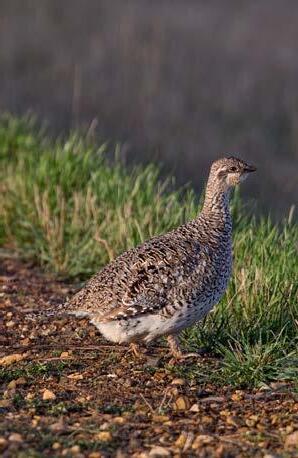
Hunters can help in the effort to manage upland game birds in the state by collecting feathers from harvested birds and sending in wing envelopes.



Birds included in the North Dakota Game and Fish Department’s upland game wing survey, which has been in practice for decades, are ringnecked pheasants, sharp-tailed grouse, Hungarian partridge, turkeys and ruffed grouse.
UPLAND GAME HUNTERS
Collecting enough pheasant samples is typically never a problem, but securing enough sharptail and partridge feathers can be.
Game and Fish biologists will take as many sharptail and partridge feathers as they can get because the more collected, the better the data. Biologists can determine sex and age ratios
UPLAND GAME MIGRATORY GAME BIRDS FURBEARER/TRAPPING
NORTH DAKOTA 2023-24 NORTH DAKOTA GAME AND FISH DEPARTMENT MAIN OFFICE AND DISTRICT OFFICES AND TRAPPING GUIDE
HUNTING
We examine and measure feathers and/or legs from pheasant, grouse and partridge harvested by hunters to determine age and sex of each bird. We use this information to assess reproduction rates and sex ratios in our upland game populations. By contributing proper samples, you can help us monitor our upland bird populations to help improve future management of these species.Thank you! DIRECTIONS: Place wings, feathers and legs in inner envelope, place up to 3 inner envelopes in this envelope and mail. Samples used by species are as follows: Pheasant Sharp-tailed Grouse Partridge PLEASE DO NOT WRAP IN PLASTIC OR PLASTIC BAGS! COUNTY WHERE SHOT: ______________________ DATE SHOT: __________ Pheasant _______ Sharp-tailed Grouse _______ Partridge ________ Name and Address of Hunter: Check Here If You Want More Envelopes: A C Wingtip cut at line B Wingtip cut at line B Entire wing cut at line A Feathers from top of head 2 longest tail feathers Lower leg B B 28 ■ ND OUTDOORS ■ AUGUST-SEPTEMBER 2023
from wings and tail feathers, survival, nesting success, hatch dates and overall production.
What biologists learn from the samples is vital to helping manage North Dakota’s upland game birds.
Hunters interested in receiving wing envelopes should visit the Game and Fish website, gf.nd.gov, or contact the Department’s main office in Bismarck at 701-328-6300 or email ndgf@nd.gov.
Hunters can also get wing envelopes at Game and Fish District offices in Devils Lake, Jamestown, Riverdale, Dickinson, Williston and Lonetree Wildlife Management Area near Harvey.
WMA Equipment Requirement
The North Dakota Game and Fish Department reminds hunters that tree stands, ground blinds and game cameras left on state wildlife management areas after January 31, is considered abandoned property and is subject to removal.
In addition, an equipment registration number, or the owner’s name, address and telephone number, must be displayed on all equipment requiring identification.
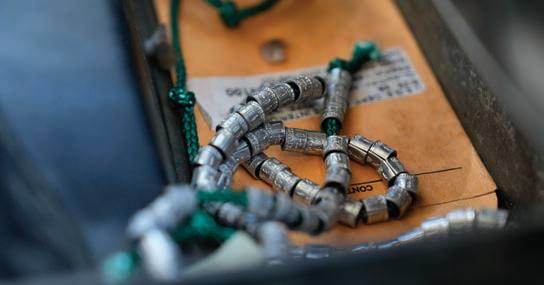
Owners can generate an equipment registration number by visiting My Account at the Game and Fish website, gf.nd. gov. One registration number will be issued that can be used on all equipment that requires identification.
Fall Fire Danger Index
As hunting seasons and other fall activities get underway, hunters and other outdoor enthusiasts need to be aware of the daily fire danger index.
There is a lot of fuel on the landscape, and hunters are urged to keep up with the daily rural fire danger index, which is issued by the National Weather Service, to alert the public to conditions that may be conducive to the accidental starting or spread of fires.
In addition, county governments have the authority to adopt penalties for violations of county restrictions related to burning bans. These restrictions apply regardless of the daily fire danger index and remain in place until each county’s commission rescinds the ban.
Hunters should consider bringing along a shovel, fire extinguisher, extra water and heavy fabric for putting out accidental fires. However, individuals who are not trained firefighters should not attempt to fight a fire that is out of control. Instead, contact the nearest rural fire department immediately.
Also, hunters should stay clear of tall vegetation when parking a vehicle.
The fire danger index can change daily depending on temperature, wind and precipitation forecasts. If the index reaches the high, very high or extreme category, open burning is prohibited; off-road travel with a motorized
vehicle is prohibited, except for people engaged in a trade, business or occupation where it is required; and smoking is restricted to inside of vehicles, hard surface areas, homes or in approved buildings.
Information on current fire danger indexes is available at NDResponse.gov.
Duck Stamp Required
A federal duck stamp is required for waterfowl hunters 16 and older beginning September 1. Waterfowl includes ducks, geese, swans, mergansers and coots.
This year’s 2023-24 federal duck stamp is available for electronic purchase through the North Dakota Game and Fish Department’s website, gf.nd.gov, or at license vendors registered with the Department’s licensing system.
Physical stamps are not available at North Dakota license vendors, but can still be purchased at many U.S. Postal Service offices.
The electronic stamp is a purchase item like any other hunting or fishing license. When the purchase is completed, the electronic stamp is valid immediately. Federal duck stamp will be printed on the license certificate, along with an expiration date 45 days from the date of purchase. The physical stamp will be sent by postal mail.
The physical stamp is processed and sent by the official duck stamp vendor and should arrive to the individual buyer well before the expiration date printed on the electronic license. The physical stamp must remain in possession of the hunter after the 45-day electronic stamp has expired. Individuals who have questions regarding the status of their physical stamp can contact the federal duck stamp vendor customer service at 800-852-4897.
The federal duck stamp has a fee of $25. An additional $1.50 fee is added to cover shipping and handling costs of the physical stamp.
Bands on Birds
Hunters should check harvested migratory birds for bands this fall and report federal bands at reportband.gov.
In addition, the bird banding lab has a mobile-friendly reporting site that will aid hunters to report bands via mobile devices.
ND OUTDOORS ■ AUGUST-SEPTEMBER 2023 ■ 29
The band number, date and location of each recovery are needed. After the band information is processed, hunters can request a certificate of appreciation, and information about the bird will be returned in an email. Hunters can keep all bands they recover. Information received from hunters is critical for management of migratory game birds.
Sandhill Crane Permits Required
North Dakota’s sandhill crane season opens September 16 and continues through November 12.
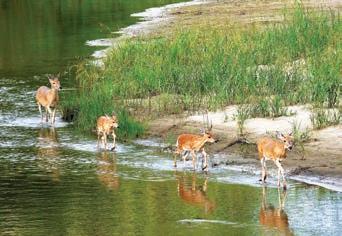
In addition to other licenses required, resident hunters need a $10 crane permit, while nonresidents need a $30 permit. Hunters can apply online at the North Dakota Game and Fish Department website, gf.nd.gov. Harvest Information Program certification is required.
PLOTS Guide Online
The North Dakota Game and Fish Department’s Private Land Open To Sportsmen Guide for 2023 is available online on the Department’s website, gf.nd.gov.
In addition, the free printed PLOTS guides are available at most license vendors and other locations throughout the state.

The guide will feature about 800,000 PLOTS acres. Because the guide is printed in mid-August, some PLOTS tracts may have been removed from the program since the time of printing. There will also be some PLOTS tracts where the habitat and condition of the tract will have changed significantly. Conversely, Game and Fish maybe have added new tracts to the program after the guide went to press.
To minimize possible confusion, Game and Fish will update PLOTS map sheets weekly on its website.
The PLOTS Guide features maps highlighting these walk-in areas, identified in the field by inverted triangular yellow signs, as well as other public lands.
The guides are not available to mail, so hunters will have to pick one up at a local vendor or Game and Fish offices or print individual maps from the website.
Pull to the Right
North Dakota hunters need to be cautious of farm, ranch and other traffic when traveling on rural roads.
Fall is a busy time in the state as farmers and ranchers are harvesting crops, moving cattle, hauling bales and moving heavy machinery. Knowing this, hunters driving around on country roads should slow down when meeting another vehicle and pull well to the right when topping a hill.
To maintain positive landowner/hunter relations, Game and Fish Department officials said hunters should move to the right side of the road to allow wide farm vehicles to pass, park vehicles in a place that will not block a roadway, field approach or gate, pick up trash and empty shells, and not clean game in the road ditch or approach.
Watchable Wildlife Photo Contest
Watchable Wildlife Photo Contest
Photographers interested in sending photos for the North Dakota Game and Fish Department’s Watchable Wildlife Photo Contest must follow guidelines for submitting their work.
Photographers should go to the Game and Fish Department’s website at gf.nd.gov/wildlife/watchable-photo-contest. Then it is a matter of providing some pertinent information about the photo and uploading it. Doing so helps both with ease of submitting photos for the photographer and managing those images for department staff.
The contest is open and the deadline for submitting photos is Oct. 2. For more information or questions, contact Patrick Isakson, department conservation biologist, at pisakson@nd.gov.
The contest has categories for nongame and game species, as well as plants/insects. An overall winning photograph will be chosen, with the number of place winners in each category determined by the number of qualified entries.
Contestants are limited to no more than five entries. Photos must have been taken in North Dakota.
By submitting an entry, photographers grant permission to Game and Fish to publish winning photographs in North Dakota OUTDOORS and on the department’s website.
30 ■ ND OUTDOORS ■ AUGUST-SEPTEMBER 2023
Gordon Gifts Artwork to Agency
The North Dakota Game and Fish Department, in cooperation with the North Dakota Council on the Arts, hosted its first Artist in Residence Program at the Department’s Outdoor Wildlife Learning Site in June.
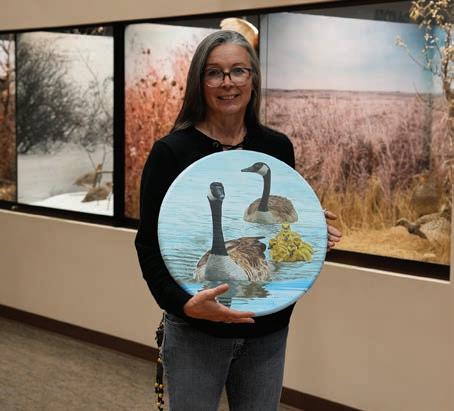
The program sought out professional artists who appreciate the natural resources and wished to provide visitors a unique opportunity to connect with the outdoors through art. Artists had to be at least 18 and North Dakota residents to be eligible for the program.
Mel Gordon (pictured left), Bismarck, was selected as the 2023 Artist in Residence, and as part of her residency, Gordon presented an onsite workshop and an exhibition of her work completed during the residency. In addition, she donated a finished piece of artwork to the Department completed during her stay.
STAFF NOTES
Jensen Earns Shack Award

Bill Jensen, Game and Fish Department big game management biologist, was honored in June with the Spirit of the Shack Award at the Midwest Association of Fish and Wildlife Agencies annual director’s meeting in Wisconsin.
The award is given to an individual who exemplifies the ideals of the honored conservationist and educator, Aldo Leopold, and who has contributed to conservation as a steward and educator in superior ways.
“By any measure of success, Bill’s accomplishments throughout his career are beyond admirable,” said Stephanie Tucker, Game and Fish Department game management section leader. “Yet, Bill, never seeks credit for the work he does, and instead is content with the personal knowledge that his success is success for all of us.”
Williams New PLI Biologist

Jeff Williams was hired in July as a private land biologist in Jamestown, focusing on private land management, partnerships and the Department’s Private Land Open To Sportsmen program. Williams earned a wildlife ecology research and management degree from the University of WisconsinStevens Point.
New Fisheries Supervisor Named

Aaron Slominski was recently promoted to Department district fisheries supervisor in Williston and will oversee management activities in northwestern and southwestern North Dakota. Slominski has been with the Department since 2013 as a fisheries biologist.
Hiltner Retires from Agency
Randy Hiltner retired after 36 years with the North Dakota Game and Fish Department. Hiltner joined the Department in 1987, and at the time of his retirement he was a fisheries supervisor in Devils Lake.


John Retires
Pat John, longtime North Dakota Game and Fish Department employee, retired after 29 years with the agency. John joined the agency in 1994, and at the time of his retirement was a fisheries biological technician in Jamestown.
Bill Jensen
Jeff Williams
Aaron Slominski
Randy Hiltner
ND OUTDOORS ■ AUGUST-SEPTEMBER 2023 ■ 31
Pat John

NOW AVAILABLE NDGF MOBILE APP NDGF IN APP STORE • DIGITAL LICENSE STORAGE • ONLINE PURCHASING • NOTIFICATIONS/MESSAGING • SUNRISE/SUNSET TIMES • REPORTING 32 ■ ND OUTDOORS ■ AUGUST-SEPTEMBER 2023
BACK CAST
Idon’t know much about cicadas. What I do know is that when they show up, and it’s not every summer, I can find them in the same trees just over the back yard fence. If I stand there long enough, I can eventually spot a few between the confusion of leaves and limbs, hanging out on branches doing whatever it is that they do.
They’re big, noisy bugs, nosing close to a couple inches in length, I’m guessing. They’re impressive enough that if they had means and drive to do it, they could take over parts of Burleigh County. Short of that, they could at least freak people out a little.
Years ago, when I was fishing in Wyoming, a local fly shop owner said we couldn’t leave his establishment without buying some foam cicada imitations. They were sparsely tied and as big as those pink erasers we gripped in our little hands in grade school. I thought they were a joke, and I was in on the gag for buying a couple.
I wished I had bought more. They rode like wine corks atop the confusion of currents and were often pulled under by unquestioning cutthroat trout as long as my forearm and pretty as could be.
Anyway, my gig with cicadas is that while they show up in summer, they remind me of fall. Maybe it’s because they’re relatively short-lived, much like our
By Ron Wilson
summers, which nudges my thoughts to the promise of fall.
Despite a winter that came unforgivably early and surrendered unforgivably late, fall is stacking up to promise more than we imagined months ago when reports of dead deer, and a disbelief of how much of anything with fur or feathers could survive such nonsense, dominated the chatter.
Game and Fish Department biologists have indicated, with nine days remaining in the late summer roadside brood counts, good things this fall for pheasants, sharptailed grouse and Hungarian partridge.



This news, while certainly welcome, is a headscratcher for anyone who wandered rural North Dakota last winter and witnessed pheasants, in what appeared to be a losing effort, trying to scratch out a living in the few areas where habitat and food weren’t buried under feet of snow.
Considering runoff from all that snow, and timely rains that followed in some areas of the state, the promise of good waterfowl hunting opportunities are in the air as this year’s fall flight is expected to be better than last year, considering the number of broods observed during the Department’s July brood survey was up 79% from 2022, and 88% above the long-term average.
Unfortunately, there’s no word from wildlife experts on the status of squirrels in our state as we head into fall, but I promise to find out.
ND OUTDOORS ■ AUGUST-SEPTEMBER 2023 ■ 33
RON WILSON is editor of North Dakota OUTDOORS.
North Dakota Outdoors Magazine
North Dakota Game and Fish Department
100 N. Bismarck Expressway
Bismarck, ND 58501
To renew your subscription or change your address, call 701-328-6300 or go to gf.nd.gov/buy-apply.
Often ignored, rural tree squirrels found in river bottom habitat, old farmsteads and other out-of-the-way places, typically act nothing like their urban, back yard cousins. These wilder critters provide quality hunting opportunities for those who chose to pursue them. The squirrel season opens Sept. 9 and closes Feb. 29, 2024.
gf.nd.gov/connect

connect
us
with
PHOTO BY ASHLEY PETERSON












 Rodney Gross, Upland Game Management Biologist, Bismarck
White-tailed deer.
Rodney Gross, Upland Game Management Biologist, Bismarck
White-tailed deer.







































































